Chapter 3: Entomology
Chapter Contents:
Insects are among the oldest, most numerous, and most successful creatures on earth. Insect fossils date back to over 350 million years. Estimates of insect diversity range from 5–80 million different species, with only about one million formally described so far. Insects can be found in nearly every ecosystem and habitat except the open ocean. In the typical backyard, there may be hundreds of different species of insects present at any given time.
The vast majority of insect species are beneficial or harmless to humans. Insects pollinate fruits and vegetables. They provide food for birds, fish, and other animals, including humans in some cultures. They have been a source of inspiration for the arts and sciences. They produce useful products such as honey, wax, shellac, and silk, as well as help degrade plant debris, dung, and animal carcasses. In addition, some insects feed on other insects that are considered pests by humans. Insects are an integral part of our ecosystems, and through the study of entomology, gardeners can better understand and appreciate the unique role they play in our natural world.
Benefits and Value of Insects
Not all insects are harmful or destructive. People have often gone to great trouble or expense to destroy insects only to learn that the insects were an important part of their garden, were not causing that much damage, or were actually helpful by eating other insects. A good rule of thumb is that pest insects will usually be abundant and associated with plant damage. Beneficial insects, or those that are harmless, are generally less abundant and not associated with plant damage. If all else fails, make note of the insects you see in your yard. If you are unsure if they are pests or not, monitor and revisit areas where you saw them. Take action against them only if you find plant damage.
Insects are beneficial to the gardener in many ways. Insects aid in the production of fruit, seeds, vegetables, and flowers by pollinating the blooms. Many of our common fruits and vegetables are pollinated by insects. Squash, tomatoes, beans, okra, peppers, apples, peaches, citrus, berries, and grapes all require insect activity to set fruit. Insects also pollinate many ornamental plants. The lack of insect activity in greenhouses can be a problem if the plant requires an insect pollinator to produce fruits or seeds. Insects can attack undesirable weeds in the same way they injure crop plants. Insects improve the physical condition of the soil and promote soil fertility by burrowing through the surface layers. Their droppings and dead bodies fertilize the soil. Insects scavenge and consume dead plants, dead animals, and dung.
Insects offer many services to our environment – from feeding fish, birds, and other animals to pollinating flowers. One service offered by insects is the control of plant-feeding insects by insect predators and parasitoids. Predators are insects (or other animals) that catch and eat other animals (their prey), usually in a single meal. Prey animals are usually small and weaker than the predator. Ladybugs, lacewings, assassin bugs, and dragonflies are good examples of predators. In contrast, parasitoids are insects that live on or in the bodies of another living animal (the host), from which they get their food for at least one stage of their development. The hosts of parasites are usually larger and stronger than the parasitoid, but parasitoids eventually kill their host. Most parasitoids are found in the orders Hymenoptera and Diptera. These are important natural enemies of many plant-feeding pests.
Insect Form and Structure—Morphology
All adult members of class Insecta are identifiable by having three body regions, three pairs of legs, and one pair of antennae. Most adult insects have two pairs of wings, although some have only one pair and some are wingless. The legs, antennae, wings, mouthparts, and other appendages are often greatly modified to suit the habitat where the insect lives and what it eats. These appendages can be very useful in determining the order to which an insect belongs.
The three regions of the adult insect body are the head, thorax, and abdomen. Sometimes the division between two regions is not always obvious. It is helpful to remember that the eyes, mouthparts, and antennae are found on the head and the legs and wings are found on the thorax. The abdomen is primarily important for digestion and reproduction.
Insects do not have an internal bony skeleton. The insect body is supported by an exoskeleton, a tough outer body wall. The outer layer of the exoskeleton, the cuticle, is made of chitin, a strong and flexible material. However, chitin is not very hard so the body wall also includes sclerites, hardened plates that offer stronger protection. Together, this combination of sclerites connected by thin, flexible cuticle is a structural feature that has helped arthropods colonize nearly every habitat on Earth. In addition, the cuticle has an outer layer of wax that limits water loss and prevents desiccation, a very important survival feature for insects. The cuticle of an immature insect is often softer than that of the adult.
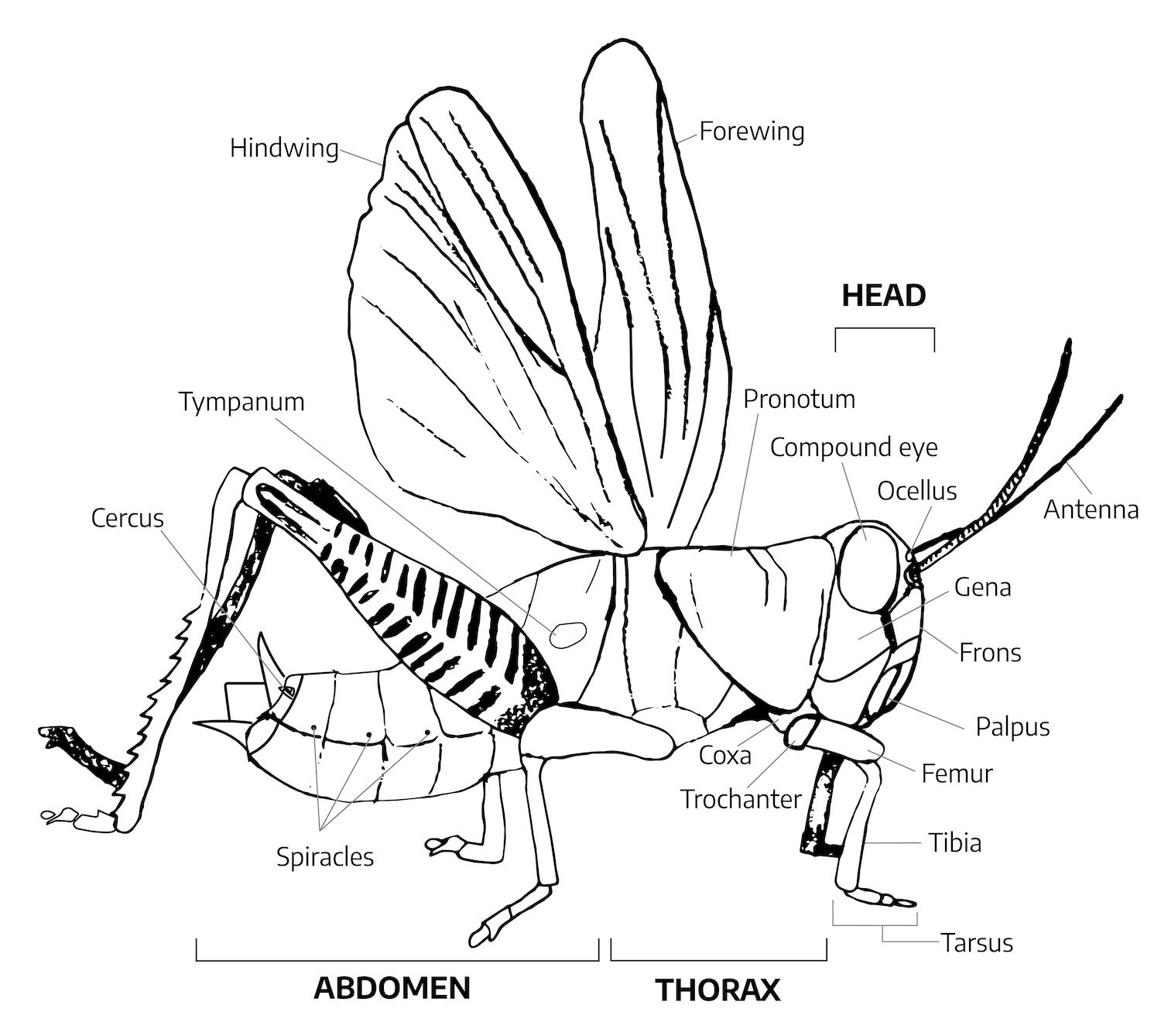
Head
The insect head is primarily involved with eating and sensory perception. The main features of the insect head are the eyes, antennae, and mouthparts. These organs may be highly specialized among orders and families.
Antennae
The antennae are a prominent and distinctive feature of many insects. Adult insects have one pair of antennae located usually between or in front of the compound eyes. Antennae are segmented and vary greatly in form and complexity. The antennae are primarily organs of smell, but may serve as organs for taste, touch, and/or hearing.
Mouthparts
Insect mouthparts are complicated structural features, and they vary greatly in form and function. Most types of insect mouthparts can be divided into two broad categories: those adapted for chewing and those adapted for sucking. There are also intermediate types of mouthparts: rasping-sucking, as found in thrips, and chewing-lapping, as found in honey bees, wasps, and bumble bees. Piercing-sucking mouthparts are typical of the Hemiptera (bugs, aphids, scales, and mealybugs), blood-sucking lice, fleas, mosquitoes, and the biting flies. Butterflies and moths have siphoning mouthparts for feeding on nectar. House flies and many other flies have sponging mouthparts.
The mouthparts of immature insects may differ from the adults. Larvae generally have chewing mouthparts regardless of the kind possessed by the adults. Nymphs have mouthparts similar to those of the adults. In some adult insects, the mouthparts are vestigial (rendered functionless) because the adults do not feed.
Some types of insect mouthparts are diagrammed in figure 3-2: a) chewing-lapping (honey bee), b) sponging (house fly), c) piercing-sucking (mosquito), d) siphoning, coiled (butterfly), e) chewing (grasshopper).
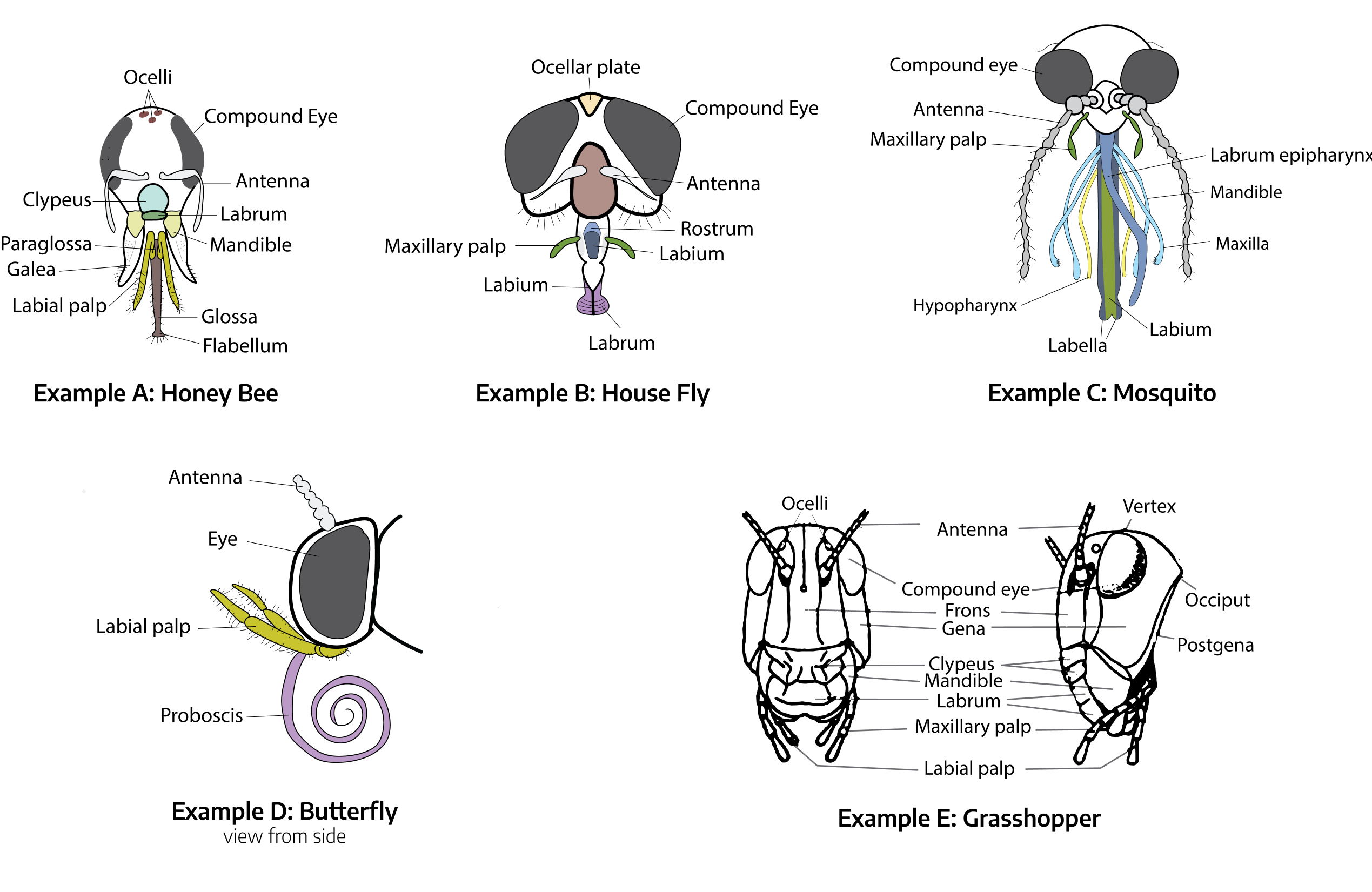
Thorax
The thorax is made up of three segments, each bearing a pair of legs. Most adult insects possess two pairs of wings that are attached to the second and third segments of the thorax.
Legs
The most important characteristic for identifying something as an insect is the presence of three pairs of jointed legs. These are almost always present on adult insects and are generally present in the other stages as well. In addition to walking and jumping, insects often use their legs for digging, grasping, feeling, swimming, carrying loads, building nests, and cleaning parts of the body. The legs of insects vary greatly in size and form and are frequently used in insect classification.
Leg adaptations of some insects are diagrammed below, (left to right): swimming (diving beetle), grasping (praying mantis), jumping (grasshopper), running (beetle), digging (mole cricket).

Wings
Wings are also important features of insects and the variations of wing forms can help identify insect families, genera, and even different species. Wing venation (the arrangement of veins in wings) also serves as a means of identifying insects to family or sometimes species. Wing surfaces may be covered with fine hairs or scales or they may be bare or membranous; these characteristics can be used for identification as well. Note that the names of most insect orders end in “-ptera,” which comes from the Greek word meaning “with wings.” Many order names describe some feature of the wings. Hemiptera means “half-winged” and refers to the appearance of the wings of true bugs, while Diptera means “two-winged” and refers to the fact that flies have only one pair of wings.
Only adult insects possess wings, although wing pads (areas where the wings are developing) are sometimes noticeable on older nymphs.
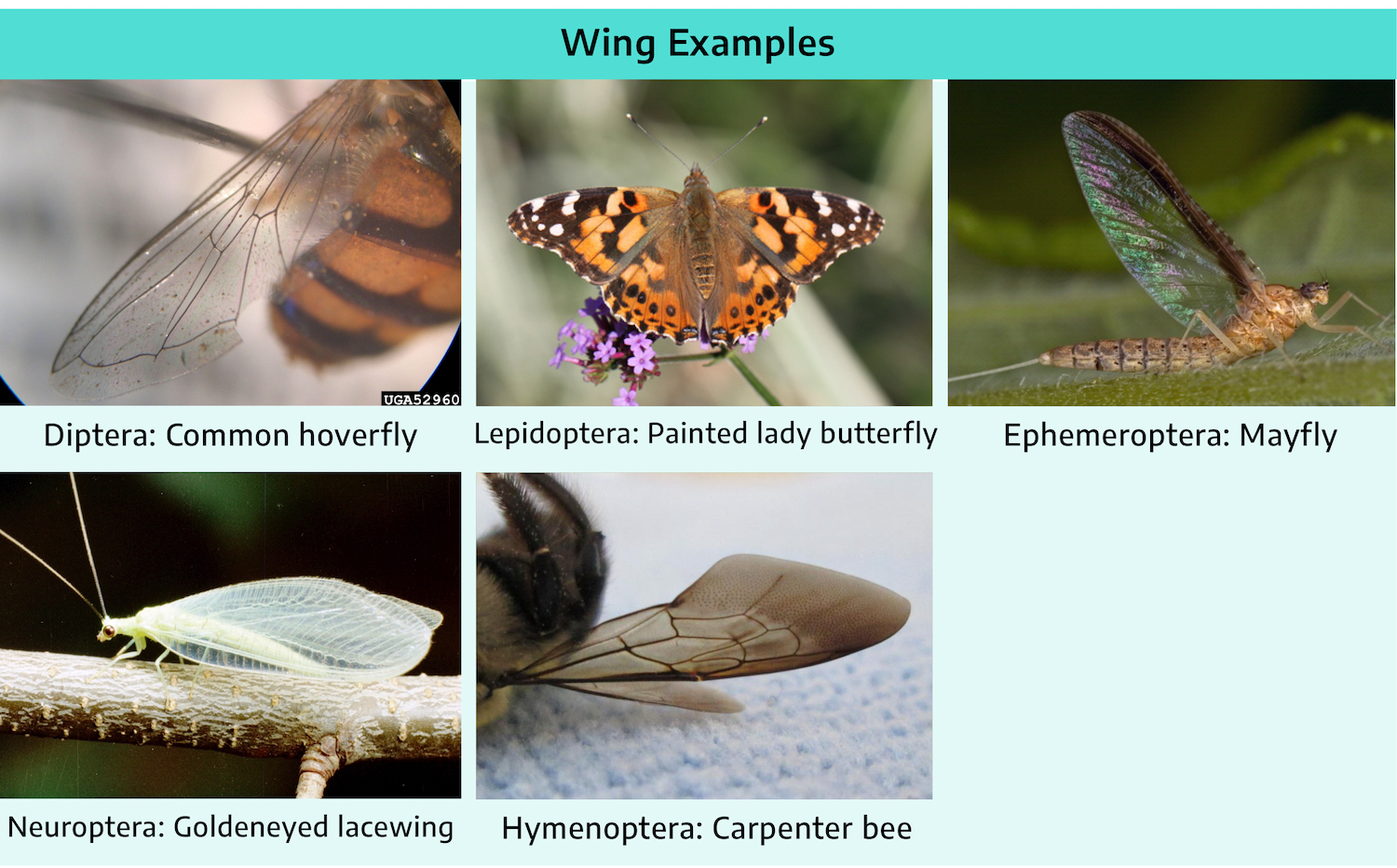
Abdomen
The insect abdomen may have 11–12 segments, but in most cases they are difficult to see clearly because the segments are short or they are covered by wings. Some insects have appendages called cerci at the tip of the abdomen. Cerci can be short, as seen in grasshoppers, termites, and cockroaches; extremely long, as in mayflies; or curved, as in earwigs.
Insect Development—Metamorphosis
As immature insects feed and grow, eventually their exoskeleton gets too tight and the insect must shed the outer skeleton in a process called “molting.” At various stages of growth, the immature insect will split open the exoskeleton and pull itself out of it wearing a soft, new exoskeleton it formed under the old one. The new exoskeleton will harden to protect the insect while giving it sufficient room to grow once it hardens. The stage of life between each molt is called an instar. The number of instars, or the frequency of molts, varies with each species and to some extent with food supply, temperature, and moisture.
In addition to molting, insects also undergo a distinctive phenomenon called metamorphosis at certain stages of their development. The term is a combination of two Greek words: “meta,” meaning change, and “morphe,” meaning form. Metamorphosis is a biological process in which an insect undergoes an abrupt change in its form from one stage of development to the next. A familiar example of metamorphosis is the change a caterpillar undergoes when it becomes a pupa, or when the adult butterfly emerges from the pupa.
Types of Metamorphosis
Without metamorphosis (ametabolous): Insects increase in size throughout their life cycle but do not change basic body structure and arrangement. The adult is wingless and looks very similar to the immature form. This is considered the most evolutionarily ‘primitive’ form of metamorphosis. Silverfish are a good example of an insect with ametabolous metamorphosis. Example orders: Protura, Diplura, Thysanura, Collembola.
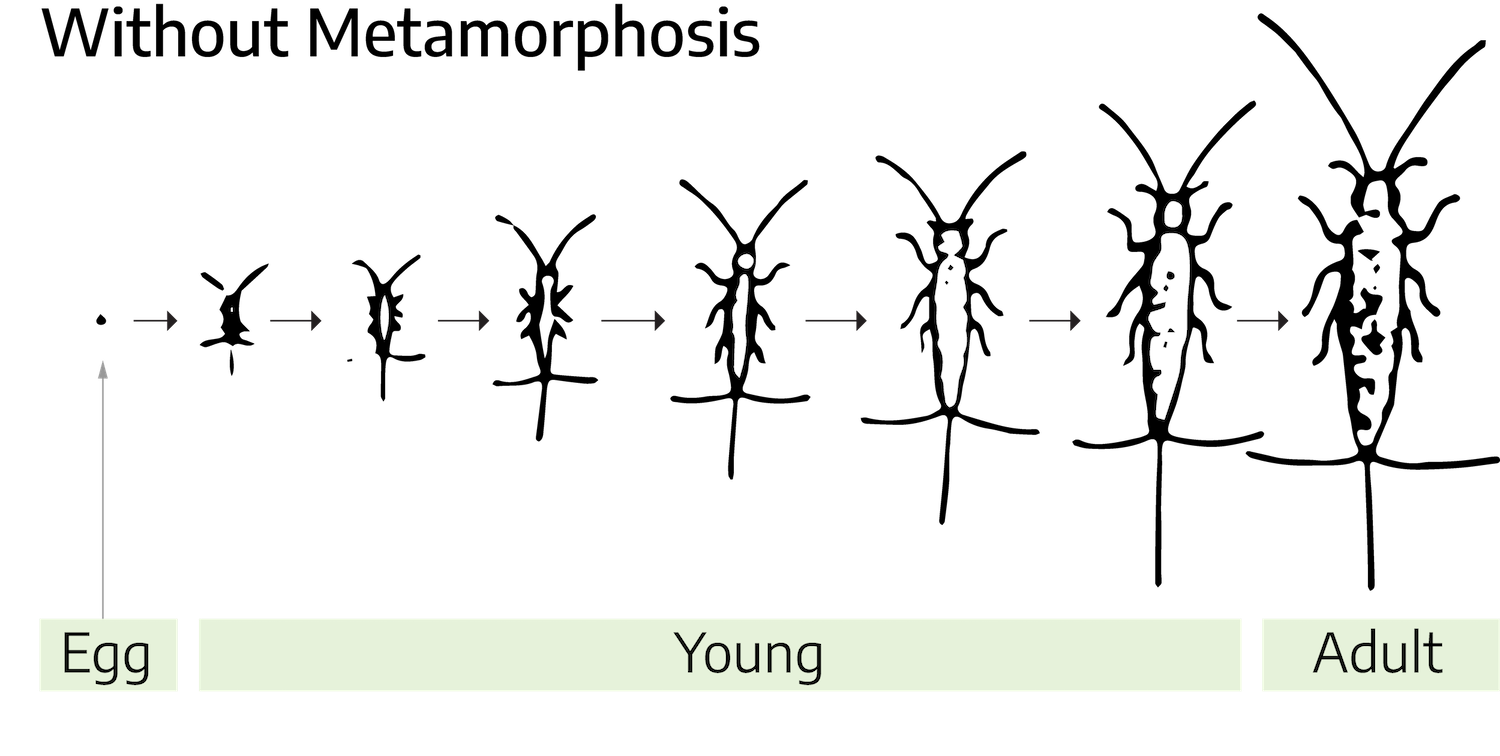
Gradual metamorphosis: Insects increase in size while maintaining the same basic characteristics throughout the life of the insect. This is the most common type of metamorphosis seen in insects. There are three stages of development in hemimetabolous insects: egg, immature, and adult. Hemimetabolous insects are usually terrestrial. The immatures, called nymphs, share similar food sources with the adult insects. Some hemimetabolous insects are aquatic, such as the dragonflies. Immature aquatic insects are called naiads and they have a different food source than the terrestrial adults. In both terrestrial and aquatic hemimetabolous insects, fully functioning wings are found only in the adult stage. These wings will appear as developing wing buds in the immature stage. Example orders that undergo gradual metamorphosis: Orthoptera, Hemiptera. Orders that undergo incomplete metamorphosis: Ephemeroptera, Odonata, Plecoptera.

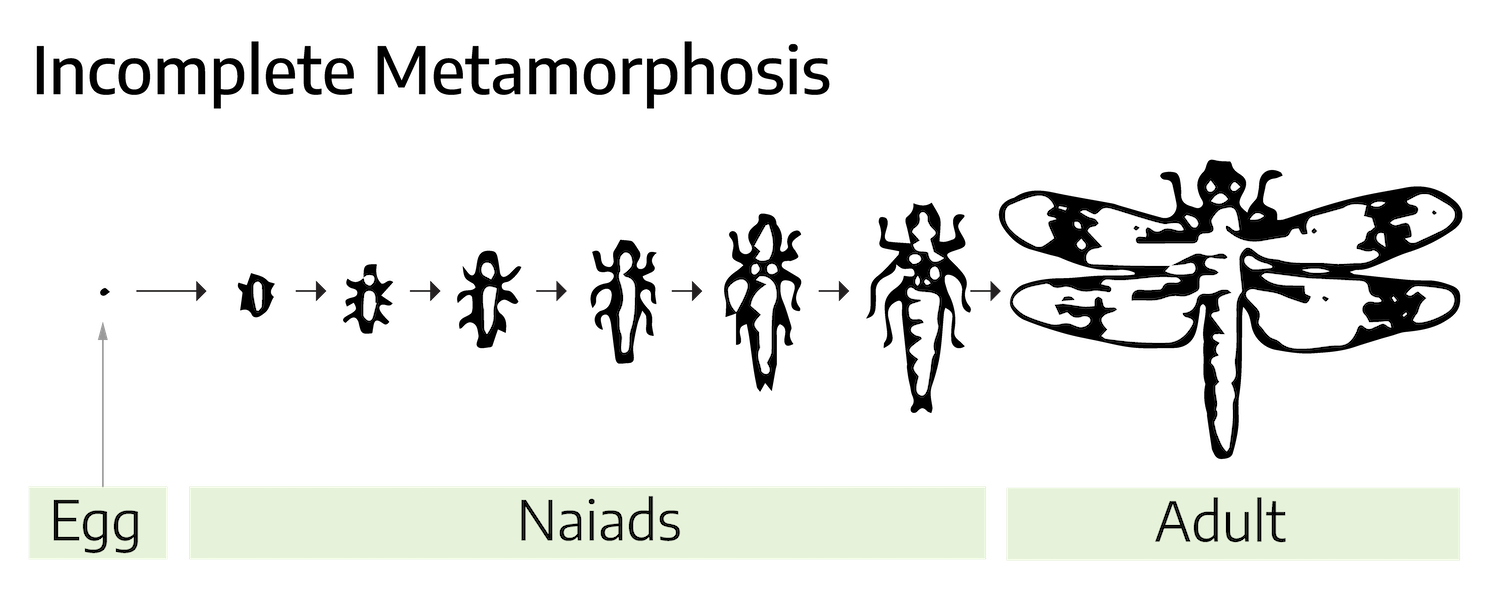
Complete metamorphosis (holometabolous): Insects go through four distinct stages: egg, larva, pupa, and adult. The immature larvae differ greatly in appearance from their adult form. The profound change from larvae to adult takes place during the pupal stage. Many tissues and structures, such as the prolegs of caterpillars, are completely broken down, and true legs, antennae, wings, and other structures of the adult are formed. The larvae of holometabolous insects often use different food sources from the adults. These are considered to be the most evolutionarily advanced and biodiverse insect orders. Example orders: Coleoptera, Lepidoptera, Diptera.
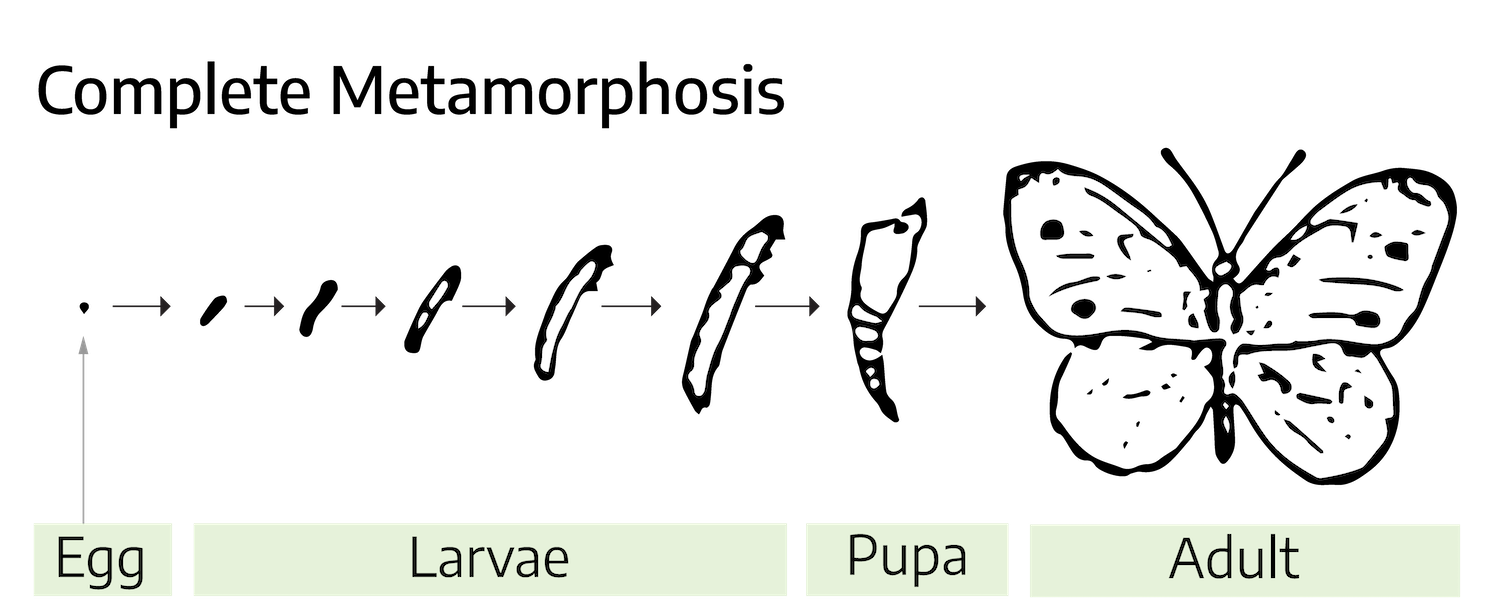
Regardless of the type of metamorphosis, the adult stage of an insect focuses on reproduction rather than feeding and growth. Some adults are very short-lived and they may not feed at all.
Identifying Insects
Some home gardeners recognize insects by the common name of their order, such as beetle, wasp, ant, or butterfly. Common names are sometimes regional and occasionally inaccurate. For example, a June bug in one area may be called a May beetle in another location. However, these common names can be helpful when conversing with clients who are not familiar with insects or their scientific names.
While there are many apps and online tools available to help ID insects, becoming familiar with insect orders and basic entomology can help gardeners assess the accuracy of ID recommendations from apps (which are not always correct) and provide a starting point for online searches.
The ability to classify an insect to its correct order gives a gardener access to valuable information about that insect. This information includes the type of mouthparts the insect has, which provides clues to the type of plant damage caused by members in that order and which methods may be effective in controlling those insects. Familiarity with the life cycle of an insect can help the planning for the proper use and timing of best management practices to avoid pest problems.
Because of the sheer number of insects, their overall diversity, and their relatively small size, identification can be difficult for the beginner. Outside of having a local expert identify them, the best way for gardeners to learn insect classification is to practice using a dichotomous key. Dichotomous keys are based on an organized series of choices between mutually exclusive characteristics, arranged hierarchically from the more general to the more specific. By working through the organized set of couplets and carefully selecting answers, you can arrive at the correct identification of an organism. These keys require knowledge of insect characteristics and time spent becoming familiar with how to use the keys, but this effort will allow the gardener to quickly classify insects to the order level or even higher levels. The goal of order level keys is to familiarize the user with the basic characteristics so that eventually the keys will become no longer necessary except as a reminder when memory fails.
While the identification of adult insects can be learned with some practice, immature insects often present a greater challenge. With the exception of colorful caterpillars and some odd-looking species, many immature insects are difficult to differentiate from each other and their adult counterparts. Sometimes the immature stages look nothing like the adult stage. There are some rules of thumb to describe immature insects in relation to their adult counterparts. The following table illustrates some of the main differences.
Table 3-1: Features of immature and mature insects
| Immature Insects | Adult Insects |
|---|---|
| Sometimes worm-like or grubs | Three body regions |
| Number of legs can vary | Three pairs of legs |
| Body generally soft and/or fleshy | Usually with tough body wall |
| Lack wings | May have wings |
| Most move slowly | Most can move quickly |
In some cases we are more dependent upon host and habitat information to help us identify insects in question. Knowing the host plant can go a long way to figuring out the insect (for example, tomato hornworms aren’t usually found on oak trees). Some key questions can offer important clues to the identification of the immature insect. Where were the insects found? What are the insects eating? What kind of mouthparts do they have? Do they have legs? If so, how many legs? What color are the insects?
For your reference, the insect orders have been divided into three sections: those containing insects important to the gardener, those containing insects of lesser importance to the gardener, and common “noninsect” pests in Virginia. The orders containing insects of importance to home gardeners will be considered in detail.
Resources for Identifying Insects
There are many insect identification keys available in textbooks, field guides, scientific papers, and on the Internet. Start with keys that are simple, such as those for the order level, and do not rely on scientific terminology. A good key for beginners are the following books: A Field Guide to Insects North of Mexico, by Donald J. Borrer and Richard E. White; Garden Insects of North America: The Ultimate Guide, by Whitney Cranshaw; and Bugs Rule!, An Introduction to the World of Insects by Whitney Cranshaw. In addition the website bugguide.net is a fabulous resource for images of insects and other arthropods. Experts on this website may be able to assist with the identification of an arthropod if a high-quality image can be uploaded to the site. Most of the characteristics used to identify an insect to order can be seen with a 10X magnifier, although it is easier with a dissecting microscope and a good light source. Once an insect has been identified to order it can be more easily cross-referenced with other resources that narrow down possible suspects by habitat or food source.
Insect ID Lab
Insects can be submitted to Virginia Tech’s Insect ID Lab for identification. Important information that must be included is: host plant or location found, date, description of damage, when it was first found, and if control information is required. Since an Extension office is an excellent resource on local pests, identifications can often be obtained at that office without sending a sample to state identifier.
Watch: Basic Entomology and the VT Insect ID Lab with Eric Day
Types of Insect Injury
Sometimes it is useful to classify insects in groups according to how they feed or damage plants. Members of these groups, also called guilds, all share a common manner of injuring plants even though they may belong to different insect orders.
Injury by Chewing Insects
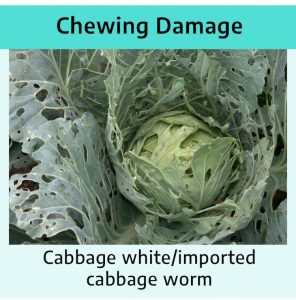
Insects take their food in a variety of ways. Many insects feed by chewing off the external parts of a plant, so they are called “chewing insects.” Examples of this type of plant injury are easy to find. Perhaps the best way to appreciate the prevalence of this type of damage is to look for leaves of plants in late summer that have no sign of leaf chewing. Cabbage worms, armyworms, grasshoppers, Colorado potato beetle, and fall webworm are common examples of chewing insects. Often chewing insects merely browse the leaves and do not cause a significant amount of plant damage beyond aesthetics. Significant plant damage occurs when large numbers of insects defoliate a significant portion of the leaf and impair its ability to make food for the plant. Plant species differ in their responses to insect damage, and this should be a consideration in pest management.
Injury by Piercing-Sucking Insects
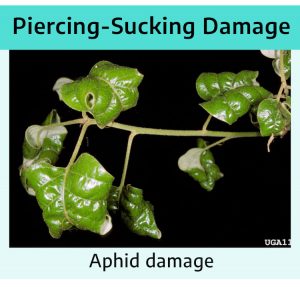
Other insects feed by piercing plant tissue and sucking sap from the plant’s cells. Only internal liquids from the plant are ingested, not portions of the tissue. Insects that feed this way have slender, sharp mouthparts that are inserted into the plant and used like a straw. The injury to the plant is physically small and very difficult to see with the naked eye, but the withdrawal of sap can result in: minute, spotty discolorations on leaves, fruit, and stems; curling or puckering of leaves; deformed fruit and seeds; witch’s broom growths; or a general wilting and dying of the entire plant. Aphids, squash bugs, scale insects, leafhoppers, and other members of the order Hemiptera are all piercing-sucking insects. Many of these pests also carry plant diseases and transmit them when they feed.
Injury by Internal Feeders
Some insects feed within plant tissues for all or part of their development. They gain entrance to plants either when an adult female inserts her eggs into part of a plant, or by eating their way into the plant after hatching from eggs deposited on the plant. In either case, the entrance hole is small and hard to see. Large holes in fruit, seeds, stems, or trunks usually indicate where an insect has left the plant, not where it entered.
The chief guilds of internal plant feeders share a common name for their group. Borers feed in wood or pith; worms or weevils are found in fruits, nuts, or seeds; leaf miners live within the thin layers of leaf tissue; and gall insects form characteristic homes from leaves, stems, twigs, and roots. These guilds are some of the most important insect pests. Nearly all internal feeding insects live inside the plant only during part of their lives and usually emerge as adults. Control measures are most effective when aimed at emerging adults or the immature stages before they enter the plant, where they are hidden from sight and well protected.
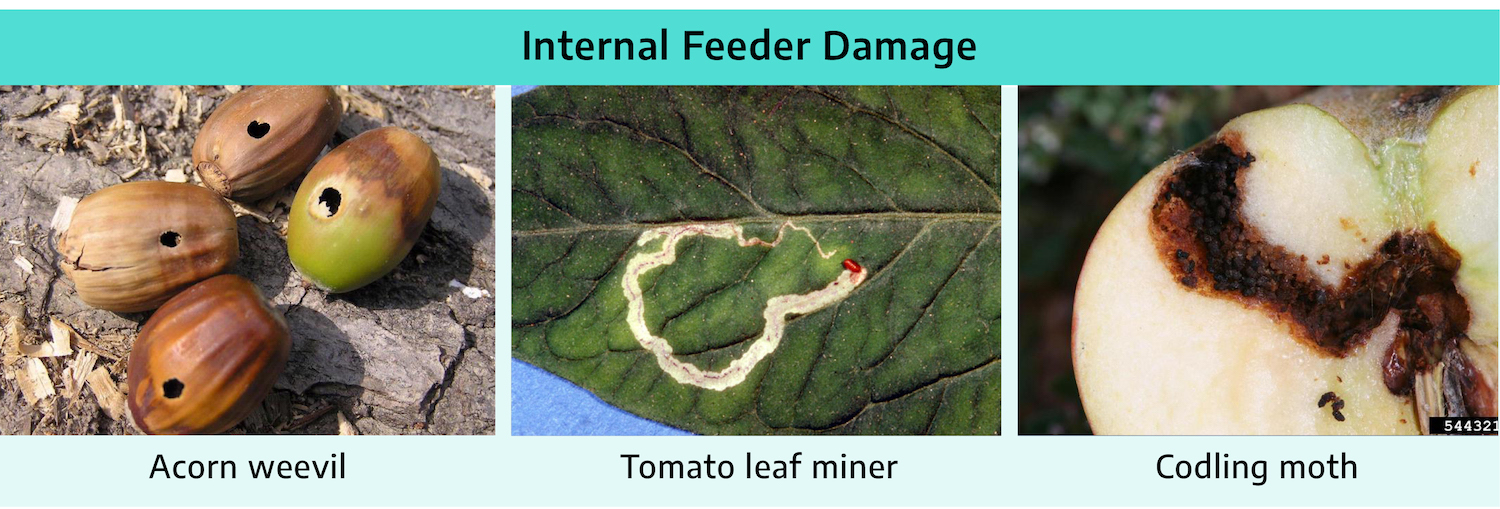
Injury by Subterranean Insects
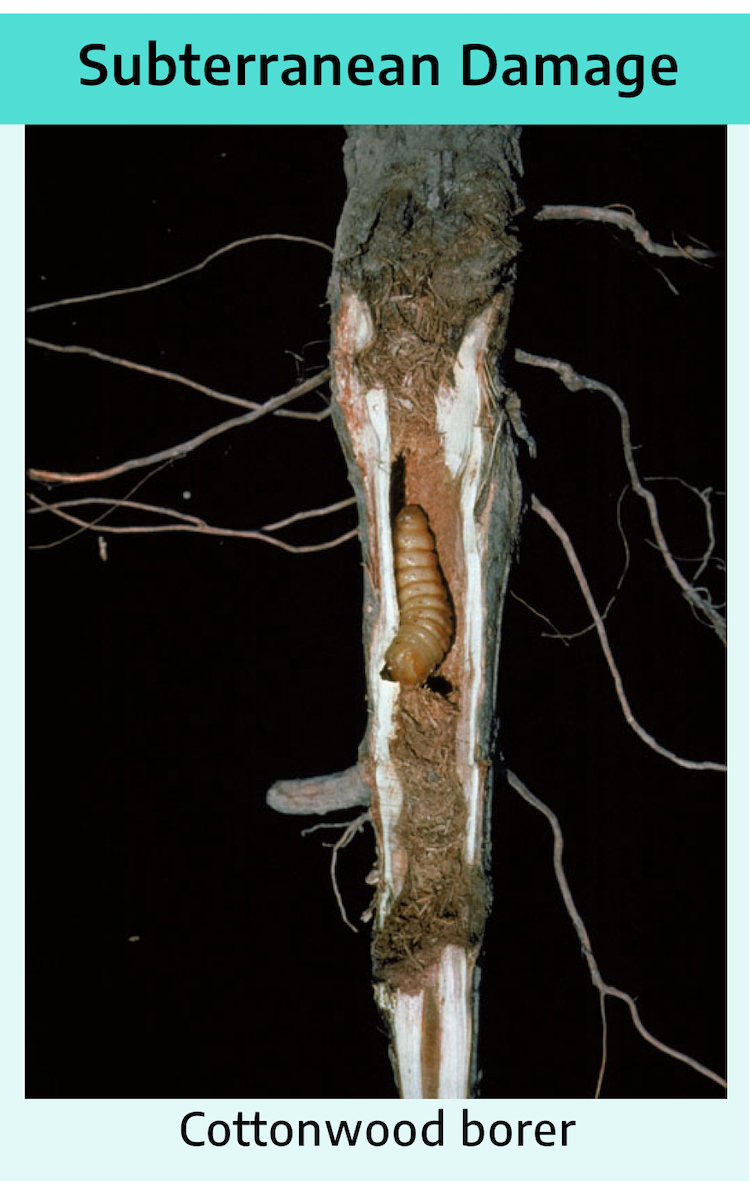
Insects that attack plants below the surface of the soil are also hidden from sight. These subterranean insects include chewing and sucking insects, root borers, and gall insects. Some subterranean insects spend their entire life cycle below ground. For example, the woolly apple aphid sucks sap from the roots of apple trees as both nymph and adult, causing the development of tumors and subsequent decay of the tree roots. Other subterranean insects have at least one life stage found above ground. Examples include wireworms, root maggots, strawberry root weevil, and corn rootworm. These larvae are root feeders while the adults live above ground.
Injury by Egg Laying
Probably 95% of the plant injury caused by insects is due to their feeding in the various ways just described. Some insects also cause damage by laying eggs in critical plant tissues. The periodical cicada deposits eggs in 1-year-old-growth of deciduous trees, splitting the wood so much that the twig may break and die. When they hatch, the nymphs drop to the ground and feed on roots in the soil but cause no further damage to the canopy.
Female gall insects lay eggs in plant tissues. The plant responds by forming a gall where the female laid her eggs, which houses and feeds the developing immature insects. Galls are abnormal growths of deformed stem, leaf, root, or bud tissue. They can be distinctive enough that the attacking insect can be identified to species based solely on the size and shape of the gall. Gall formation is likely initiated by chemicals produced by the female laying her eggs, but continued development of the gall relies on the mechanical damage by larval feeding and secretions from the developing grubs.
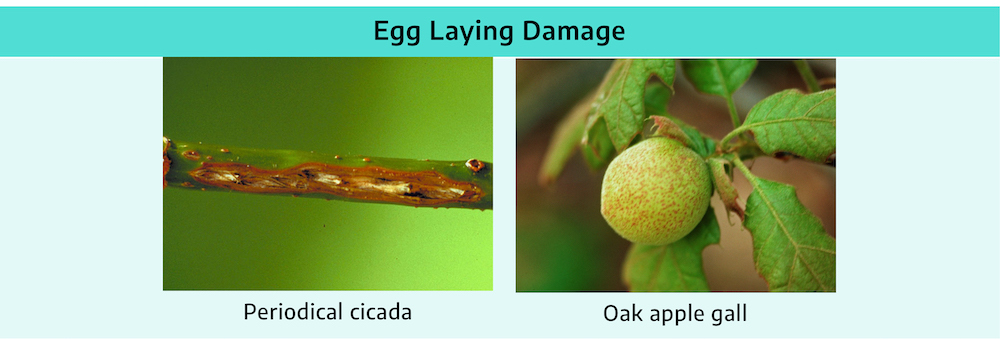
Use of Plants for Nest Materials
Insects sometimes remove parts of plants for the construction of nests or to provision nests. Leaf-cutter bees neatly cut circular pieces of foliage from roses and other plants to line the brood cells of their young.
Insects as Vectors for Plant Diseases
There are over 200 plant diseases spread by insects. Viruses produce the majority of plant diseases vectored by insects, followed by fungi, bacteria, and some protozoa. One example is fire blight of apples and related fruit trees, which is caused by bacteria and spread by honey bees and other pollinators.
Insects can spread plant disease in the following ways:
- By creating wounds when feeding, laying eggs, or boring into plants. These are entrance points for a disease that is not actually carried by the insect.
- By carrying and disseminating the causative agent of a disease in or on their bodies from one plant to the next. This is a passive transfer of pathogens.
- By carrying pathogens in or on their bodies and actively transferring the pathogen into the host as they feed.
- By serving as an essential host for some part of the pathogen’s life cycle. The pathogen could not survive without the insect host.
Examples of diseases where the insect is the vector:
- The fungus responsible for Dutch elm disease and the elm bark beetle.
- The virus responsible for tomato curly top and the beet leafhopper.
- The virus responsible for tomato spotted wilt and thrips.
- The bacteria responsible for Stewart’s disease in corn and corn rootworm and flea beetles.
- The virus responsible for rose rosette disease and eriophyid mites.
Insects of Importance to the Gardener
Orthoptera: Grasshoppers, Crickets, Katydids
- Adults can be moderate to large insects, often with hard bodies.
- Hind legs are modified for jumping. Antennae can be very long.
- They undergo gradual metamorphosis. Nymphs resemble adults but lack wings.
- Adults have two pairs of wings. The forewings are elongated, narrow, and hardened. Hindwings are membranous with extensive folded areas. Some species have reduced wings or may be wingless.
- Many orthopterans “sing” or chirp by rubbing one part of their body against another.
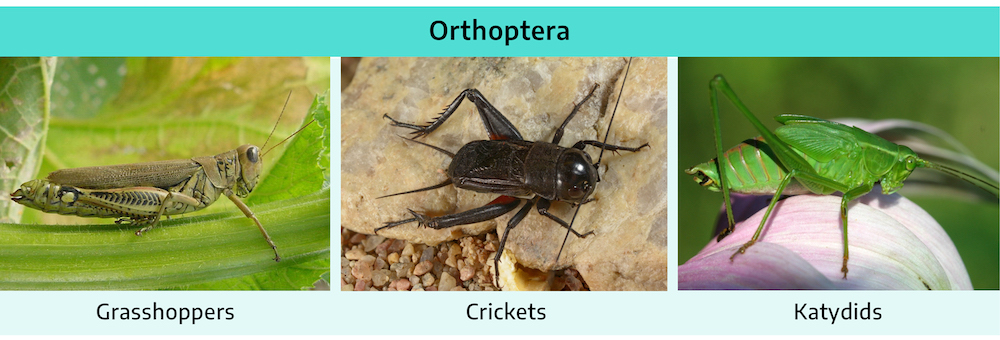
Blattodea: Cockroaches and Termites
- Both cockroaches and termites have chewing mouthparts.
- Both cockroaches and termites undergo gradual metamorphosis. Nymphs generally resemble the adults but without wings.
- Cockroaches have oval, flattened bodies and are usually dark brown to reddish in color. They can be small to large insects. Adults may have wings, or they may be reduced in size or absent. Cockroaches are known for being fast runners.
- Termites somewhat resemble ants in shape and size, but they lack the “waist” seen in ants. They are soft-bodied and live in colonies with a complex social system. Termites feed on cellulose and are very destructive to wood. Reproductive termites have two pairs of wings, but they may shed them quickly.
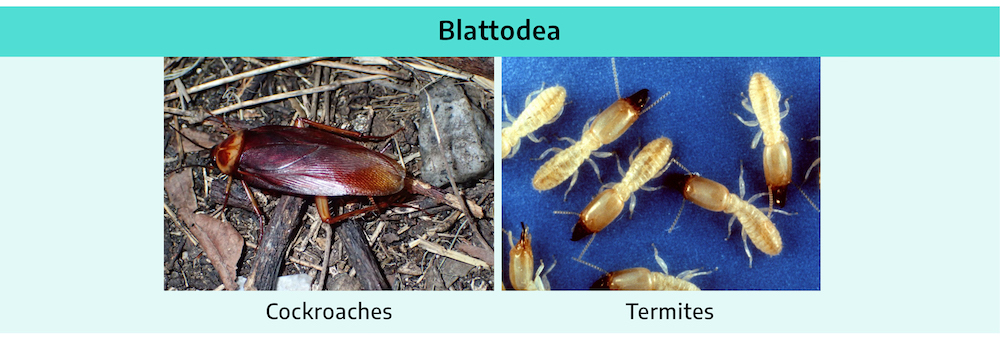
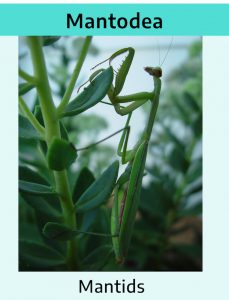
Mantodea: Praying Mantises, Mantids
- Adults can be moderate to large insects.
- They have elongated bodies, large eyes, and front legs modified for catching their prey.
- Adults have two pairs of wings. The forewings are elongated, narrow, and hardened. Hindwings are membranous with extensive folded areas.
- They undergo gradual metamorphosis. Nymphs resemble adults but lack wings.
- Both nymphs and adults have chewing mouthparts and eat other arthropods.
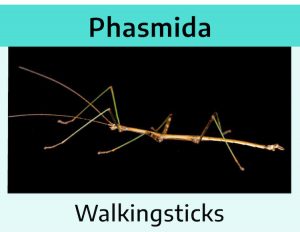
Phasmida: Walkingsticks
- Largely resemble brown or green twigs with long legs and antennae.
- They undergo gradual metamorphosis. Nymphs resemble small adults.
- Both nymphs and adults have chewing mouthparts and feed on foliage of trees.
- Typically very slow moving and may hold themselves to look like twigs.
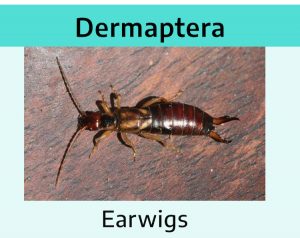
Dermaptera: Earwigs
- Adults are moderate-sized insects.
- They undergo gradual metamorphosis with both the nymphs and adults being similar in appearance.
- They are elongated and flattened, with strong, moveable forceps at the tip of the abdomen. Some species can pinch with their forceps. The forceps in the immature are somewhat weaker.
- Adults have short, hardened outer wings that cover the folded, membranous inner wings. Some adults are wingless.
- Both adult and immature earwigs possess chewing mouthparts.
Hemiptera: True Bugs, Cicadas, Hoppers, Aphids, Scales, and Allies
- This is a very large and diverse group of insects with considerable differences in appearances and life histories.
- Range from being generally small, soft-bodied insects to the large, hard-bodied cicadas.
- They undergo gradual metamorphosis, but some (like the aphids) have complex life cycles involving alternate plant hosts.
- Nymphs of true bugs (such as squash bug and stink bugs) generally resemble the adults.
- Adult true bugs usually have two pairs of wings. The first pair are “half-wings” with a thickened part close to the body and a membranous bottom half. The second pair of wings is fully membranous.
- Other adult hemipteran species may have both winged and wingless forms.
- Nymphs of scales, mealy bugs, and whiteflies can look very different from the adults.
- All homopterans (suborder of Hemiptera) have piercing-sucking mouthparts. Most are plant feeders, but some feed on blood.
- Many plant feeders transmit plant pathogens; some blood feeders carry human and animal diseases.
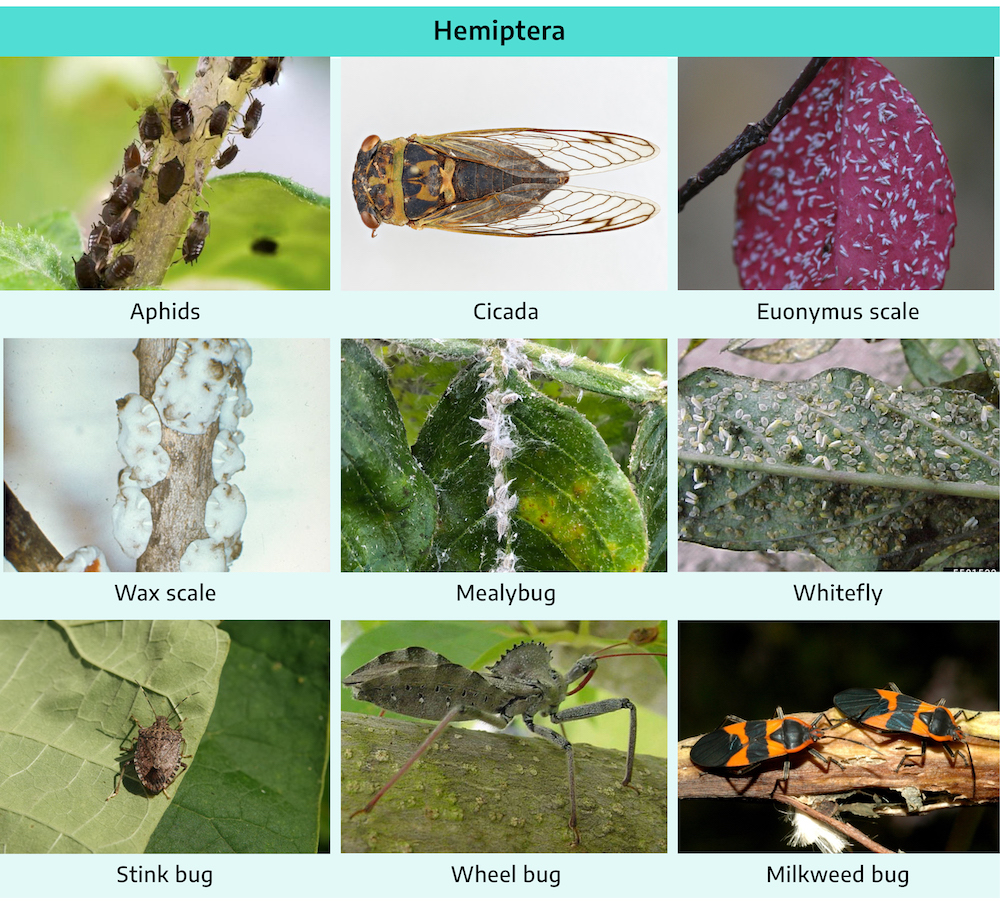
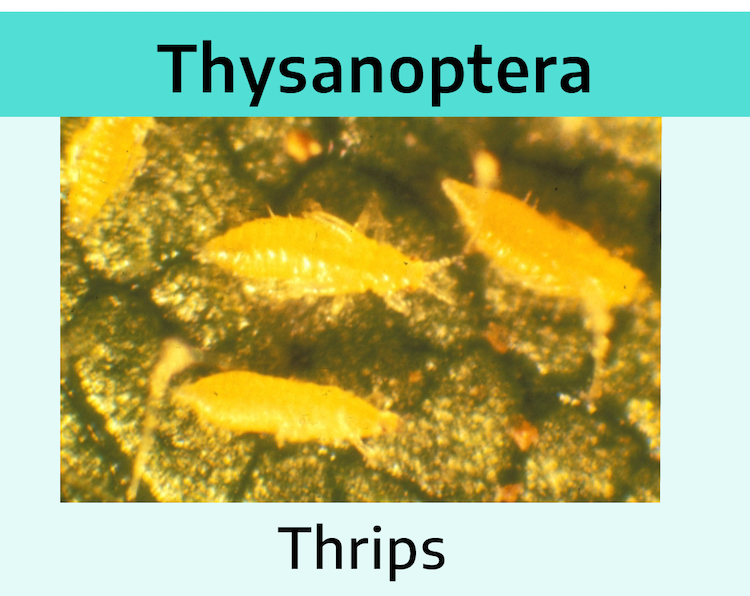
Thysanoptera: Thrips
- Called thrips whether there is one thrips or several.
- Small, soft-bodied insects.
- Metamorphosis includes a mix of gradual and complete stages.
- Mouthparts are rasping-sucking.
- Can be found on flowers or foliage of plants and may transmit plant diseases.
- Adults have two pairs of slender wings with a fringe of hairs resembling feathers.
Coleoptera: Beetles, Weevils, Borers, White Grubs
- Adults often have a hardened exoskeleton, but some species have soft bodies as adults.
- Adults usually have two pairs of wings; the outer pair (the elytra) is hard and protects the membranous inner pair. The elytra usually cover the abdomen but some species have very short elytra that do not completely cover the abdomen.
- Both adult and immature beetles possess chewing mouthparts.
- Adults usually have noticeable antennae, sometimes in very distinctive forms that can be useful in identifying them to the family level.
- Adult beetles range in size from the very tiny, approximately 1 mm long, to an inch or more in the larger species.
- They undergo complete metamorphosis. The larvae are often called grubs.
- Larvae have a head capsule, three pairs of legs on the thorax, and no legs on the abdomen. Weevil larvae, however, do not have any legs.
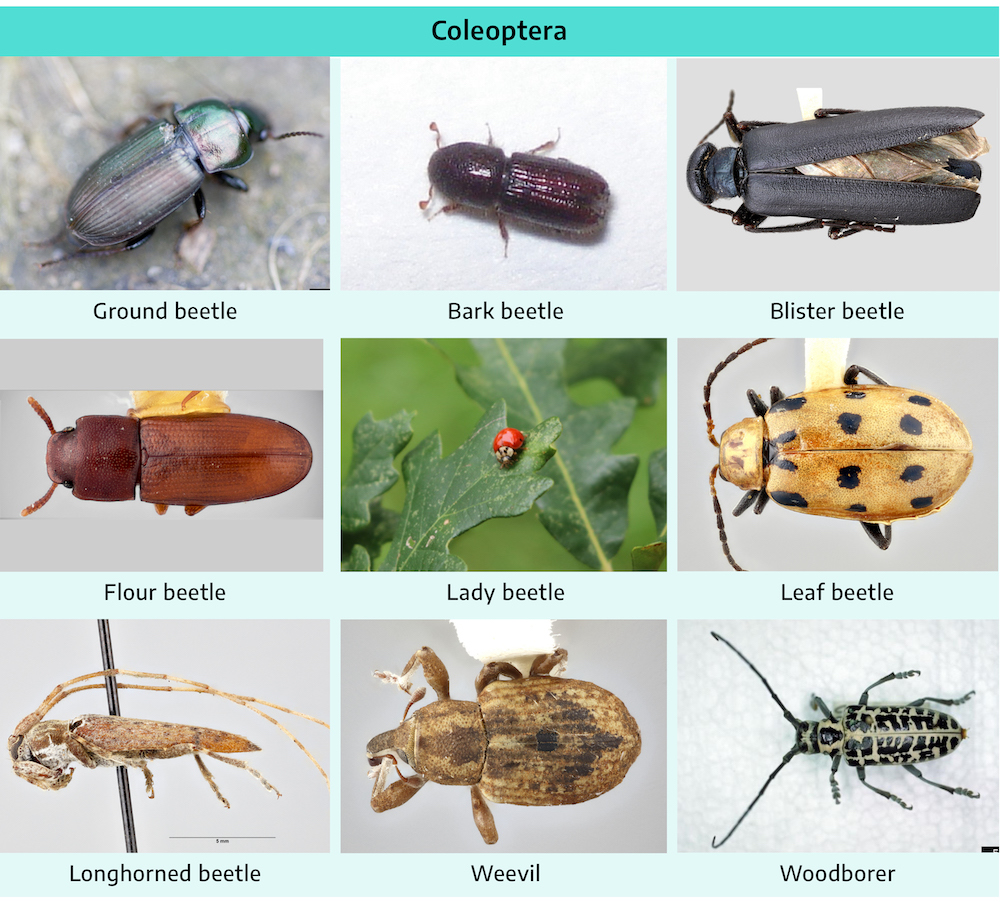
Diptera: Flies, Mosquitoes, Gnats, Midges
- Adult flies have one pair of wings, are usually soft-bodied, and often covered with hairs or bristles.
- Flies undergo complete metamorphosis.
- Most larvae are legless with chewing mouthparts or mouth “hooks.”
- Adults have sponging mouthparts, or in blood-feeders like mosquitoes, piercing mouthparts.
- Larvae of advanced flies (such as house flies) lack a head capsule, possess mouth hooks, and are called maggots.
- Larvae of lower forms (such as mosquitoes and fungus gnats) possess a head capsule.
- Blood-feeding flies (such as mosquitoes, horse flies, biting midges, and black flies) are a nuisance and can transmit diseases.
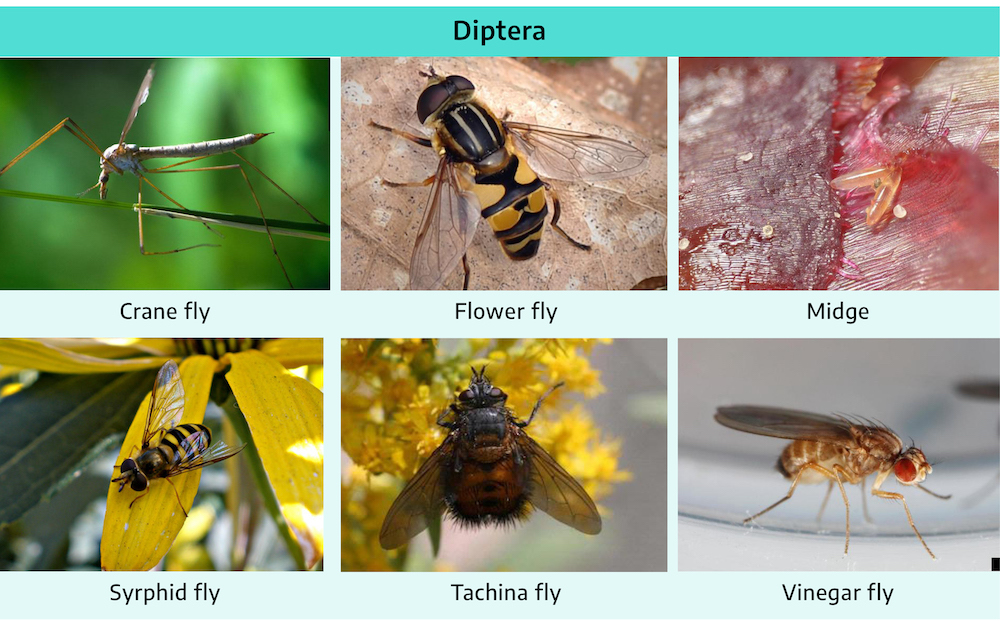
Hymenoptera: Bees, Ants, Wasps, Sawflies, Horntails
- Adults usually have two pairs of membranous wings. (Female velvet ants do not have wings.)
- Larvae have no legs except for the sawflies, with three pairs of legs on the thorax and at least six pairs of legs on the abdomen.
- Adults have chewing mouthparts and soft or slightly hard bodies.
- They undergo complete metamorphosis.
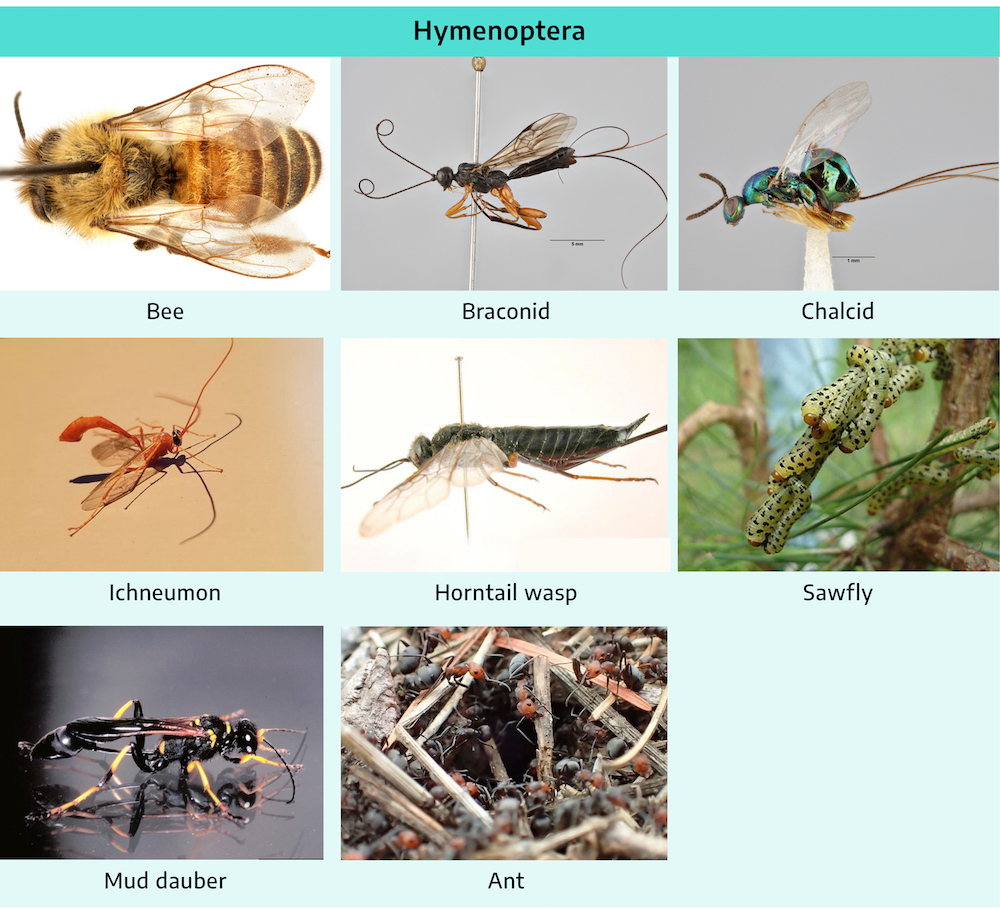
Asian giant hornet look-alikes in Virginia
Vespa mandarinia, or the Asian giant hornet, has not been found in Virginia (in the U.S., it has only been confirmed in the Pacific Northwest). A few look-alike species are found in Virginia and these are often mistaken for the Asian giant hornet. For example, the European hornet, Asian hornet/yellow-legged hornet, and the cicada killer are large insects that can be mistaken for the Asian giant hornet. For more information, see Virginia Tech’s Asian giant hornet fact sheet here.
Lepidoptera: Butterflies, Moths, Caterpillars, Cutworms
- Adults are soft-bodied with two pairs of well-developed wings covered with scales.
- They undergo complete metamorphosis.
- Larvae have chewing mouthparts while adults have a coiled, sucking tube adapted for feeding on nectar and other liquids.
- Larvae are called caterpillars; they are worm-like, voracious feeders on plants.
- Caterpillars have three pairs of legs on the thorax as well as multiple pairs of legs on the abdomen.
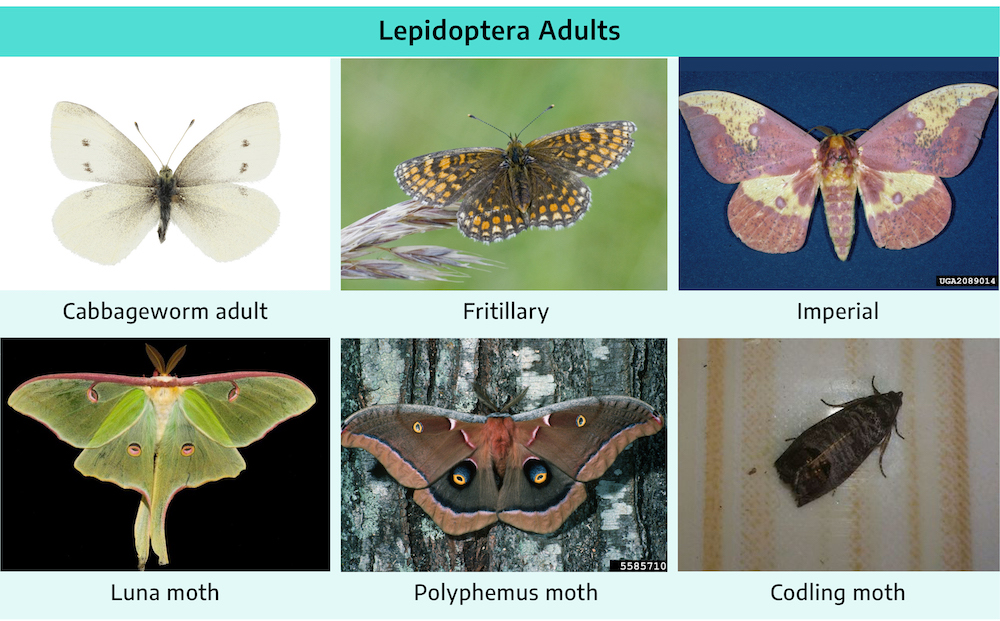
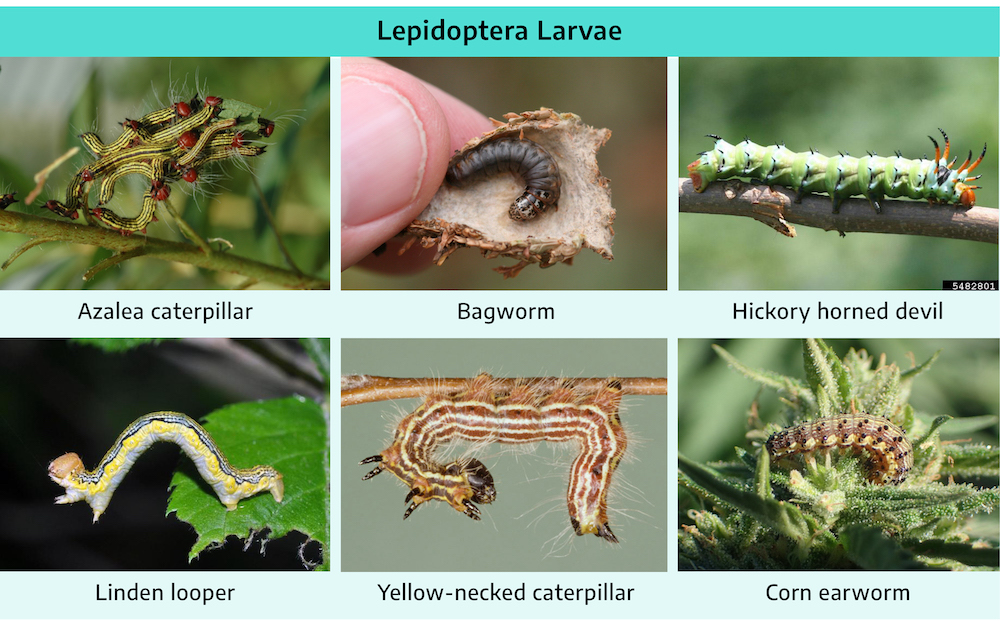
Neuroptera: Lacewings, Antlions, Snakeflies, Dobsonflies
- Many neuropterans are predators of other insects.
- Some are aquatic.
- Adults have two pairs of membranous wings held “roof-like” over the abdomen.
- Adults have chewing mouthparts and long antennae.
- They undergo complete metamorphosis.
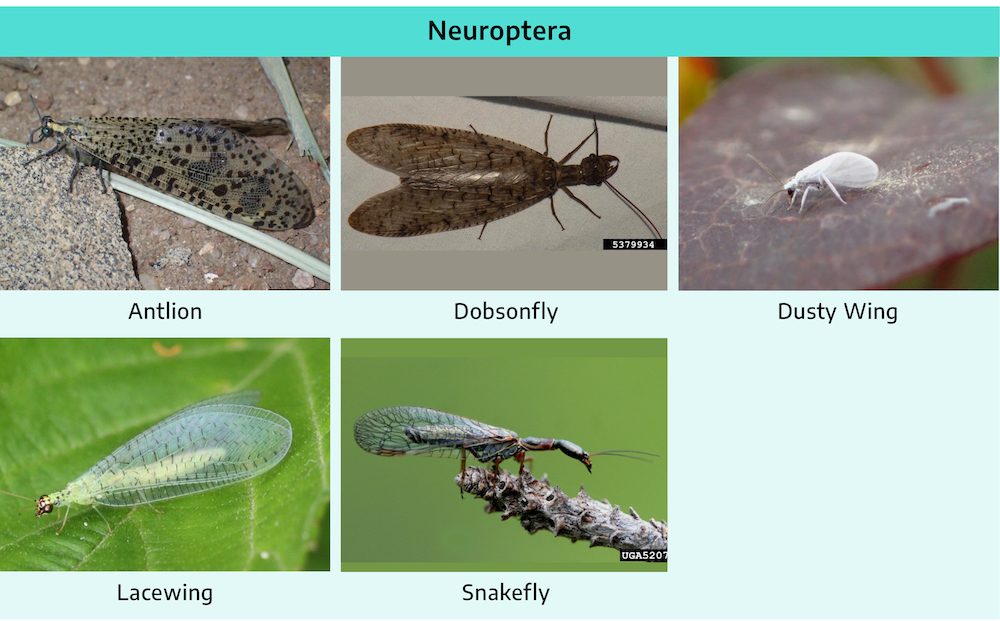
Table 3-2: Insect orders of lesser importance
(Examples, not a comprehensive list)
| Order | Example Insects |
|---|---|
| Ephemeroptera | Mayflies |
| Embiidina | Webspinners |
| Mecoptera | Scorpionflies |
| Odonata | Dragonflies, damselflies |
| Plecoptera | Stoneflies |
| Psocoptera | Booklice, barklice, parasitic lice |
| Siphonaptera | Fleas |
| Strepsiptera | Twisted-wing insects |
| Trichoptera | Caddisflies |
| Zoraptera | Angel insects |
| Zygentoma | Silverfish |
Commonly Encountered Non-Insect Arthropods
There are a variety of other arthropods seen in the average backyard. The following are some of the more common ones found in Virginia.
Arachnida: Spiders, Mites, Ticks, Daddy-Longlegs
Spiders are soft-bodied arthropods with two distinct body regions. Spiders have four pairs of legs, although some of their specialized mouthparts may be mistaken for legs. Spiders are important predators of insects and other arthropods. Many spiders spin webs to catch their prey but others ambush or actively hunt for food. Only a few species of spiders in Virginia have venom considered potentially harmful to humans. For more information, see the VCE publication “Spiders of Medical Concern” ENTO-346NP.
Mites superficially resemble very tiny spiders. They have two body regions that appear undivided and lack antennae. Most adult mites have four pairs of legs while some of the immature stages have only three pairs of legs. Many mites are plant feeders, but some are predators of other mites while others feed on animals. Spider mites that attack plants often produce noticeable sheets of webbing when their populations are large.
Ticks look much like large mites. Adults have four pairs of legs while the youngest immature stage has only three pairs of legs. They are exclusively parasitic, feeding on the blood of animals. Some species are important vectors of diseases. For more information, see the VCE publication “Common Ticks of Virginia” ENTO-487NP.
Daddy-longlegs are also known as harvestmen. These familiar arachnids have small bodies and long legs that are often several times longer than the length of the body. They are harmless and do not possess venom.
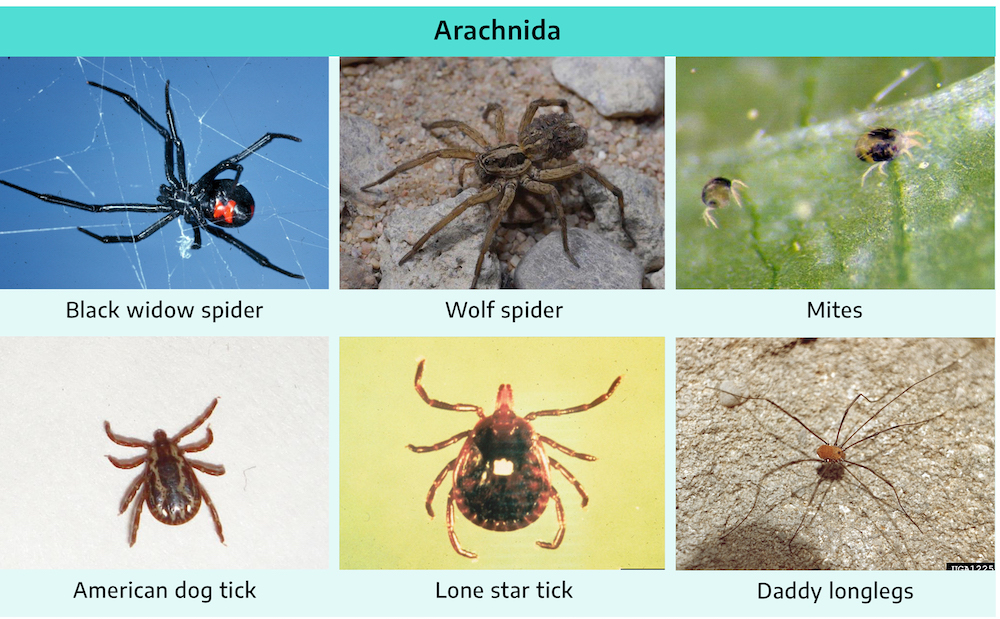
Tick populations densest in suburban forests
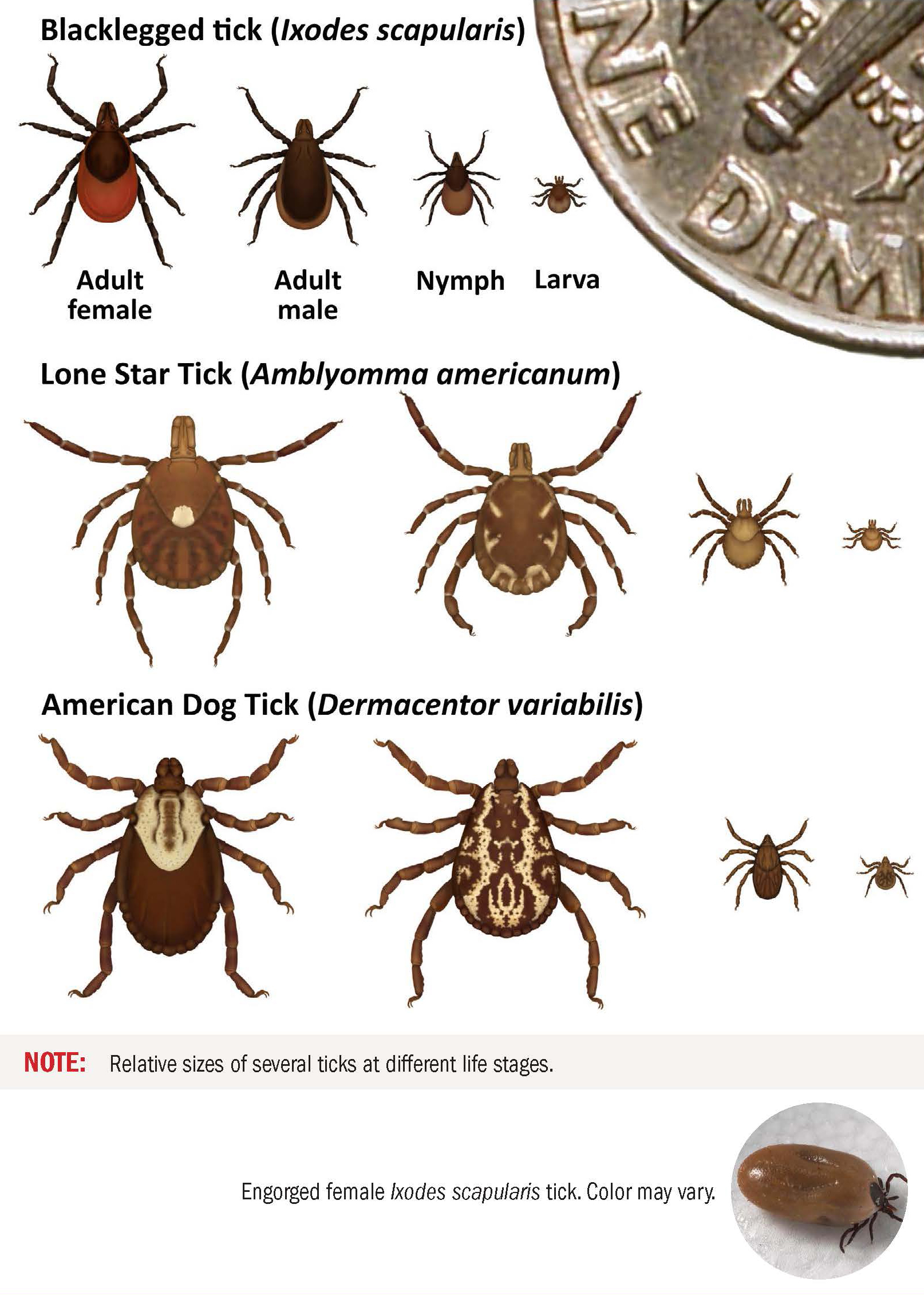
By David Gaines, State Public Health Entomologist Virginia Dept. of Health, Office of Epidemiology
Suburban forests are the most important tick prone environments for people, and persons whose homes are adjacent to suburban forests are at higher risk of exposure to ticks and the diseases that they carry than people who do not live next to such forests.
Deer hunting is generally prohibited in suburban forests due to the dangers posed to people and homes by firearms and flying projectiles. Therefore, deer population densities often become much higher in suburban forests than in rural forests. Because populations of the two most important human-biting, disease-vector tick species in Virginia (blacklegged ticks and lone star ticks) mainly use deer as their mating ground and as a source of blood used by mated female ticks to nourish the thousands of eggs she will lay, tick population densities will generally be greatest where deer population density is highest.
Blacklegged tick adults mostly meet and mate on deer during the fall and early winter season, and lone star tick males and females mostly meet and mate on deer during the late winter and early spring season. The male ticks often encounter and mate with the female ticks on a deer as the females are engorging on deer blood, and each mated female tick that has filled up with deer blood can nourish up to 3000 to 4000 eggs to lay. The fully engorged female ticks often drop off the deer and lay their eggs in these same suburban forests.
Immature lone star ticks often pick up the ehrlichia disease agents that they transmit to people by feeding on an infected deer, and immature blacklegged tick larvae that have recently hatched out of eggs often become infected with Lyme disease, or other associated disease agents, by feeding on white-footed mice (which are primarily a rodent species associated with suburban forests or forest environments that have been altered or fragmented by human activity). Additionally, suburban forest environments often offer mouse nesting habitats such as firewood piles, scrap lumber piles, leaf piles, sheds, or junk piles for the mice to nest under.
Reduce your risk:
Virginia has three tick species that can bite people and transmit diseases (lone star tick Amblyomma americanum, American dog tick Dermacentor variabilis, and blacklegged tick Ixodes scapularis), and at least 12 different disease agents and/or health conditions that can be caused by tick bites to people, including ehrlichiosis, Lyme disease, and alpha-gal syndrome (also called acquired red meat allergy).
Probably the best means of reducing the risk of blacklegged or lone star tick bites is to wear permethrin-treated shoes, socks and pants, and to always tuck the treated pants legs into the treated socks. That is because the ticks, which are primarily found in shaded areas on the ground, on leaf litter, or on very low vegetation on the forest floor, generally climb onto a person’s shoes first, and then crawl upwards until they can find some skin to attach to and feed from. Therefore, if one’s shoes, socks, and pants are treated with permethrin, and are tucked, by the time a blacklegged nymph has been forced to crawl across the treated shoes and socks, it will also be forced to climb up the treated pants legs, and will become too intoxicated from the permethrin to go much further.
Lone star nymphs move much faster than blacklegged nymphs, so they may climb up a person’s treated shoes, socks and pants, to reach the shirt level, and then may go between the buttons looking for skin to attach to. However, because that tick has crossed a large amount of permethrin-treated clothing, it typically dies inside one’s shirt without ever biting. On the other hand, if one is wearing shorts or will have a lot of hand contact with the forest floor, it is best to wear treated shoes, socks, shorts and shirt, and apply a band of deet around the ankles and wrists to serve as a deterrent/barrier to the ticks climbing any higher. Clothing that has been treated with permethrin stays effective even after a few wash cycles, and may remain effective for a full season.
For more information about ticks, see the Virginia Department of Health website and their publication “Ticks and Tick-Borne Disease of Virginia.”
Diplopoda: Millipedes
Millipedes are long arthropods whose bodies are rounded in cross section and made up of many segments. All but the first four or five body segments behind the head have two pairs of legs. Millipedes move slowly and are found in leaf litter or on the soil. They prefer humid habitats. Most are detritivores, feeding on decaying organic matter. Sometimes they can be pests to tender young plants or in greenhouses.
Chilopoda: Centipedes
Centipedes are also long arthropods made up of many segments. They tend to be flatter than millipedes, with longer antennae and only one pair of legs per body segment. The last pair of legs is held extended behind the body. Centipedes are fast-moving predators of other arthropods, with a pair of legs modified into “poison claws” that they use to inject venom into their prey. Despite their fearsome appearance, most centipedes are too small to be of medical concern to humans.
Isopoda: Sowbugs, Roly Poly, Pill Bugs, Woodlice
These are small, oval arthropods with highly segmented, hard bodies and seven pairs of legs. They require high humidity for survival. Only some isopods can roll themselves into a ball. Isopods feed on decaying plant matter and are generally harmless, but sometimes they attack young, tender plants.
Table 3-3: Commonly seen classes of phylum arthropoda
| Class | Examples | Body Regions | Pairs of Legs | Importance |
|---|---|---|---|---|
| Arachnida | Spiders, mites, ticks, harvestmen, scorpions, chiggers, etc. | 1-2 | 4 (immature ticks have 3 pairs) | Spiders prey on insects; some mites are major plant pests while others are beneficial predators; ticks, some mites and spiders, and scorpions are of medical importance |
| Chilopoda | Centipedes | 15+ | 15+, 1 pair per segment | Predators of insects, spiders, and other small animals; some are household pests |
| Collembola | Springtails | 3 | 3 | Feed on decaying organic matter can be pests of houseplants |
| Diplopoda | Millipedes | 2 (body can have many segments) | Generally 2 pairs per segment | Feed on decaying organic matter |
| Diplura | Two-pronged bristletails | 3 | Feed on decaying organic matter | |
| Insecta | Beetles, true bugs, flies, butterflies, wasps, fleas, etc. | 3 | 3 | Mostly beneficial with some pest species |
| Malacostraca | Crabs, lobsters, shrimp, sowbugs | 2 | 5 | Many aquatic orders; some considered delicacies; predators and scavengers |
| Protura | Coneheads | 3 | 3 | Feed on decaying organic matter |
| Symphyla | Symphylans, garden centipedes | 2 (body can have many segments) | 10-12 | Feed on decaying organic matter; can be pests in agriculture |
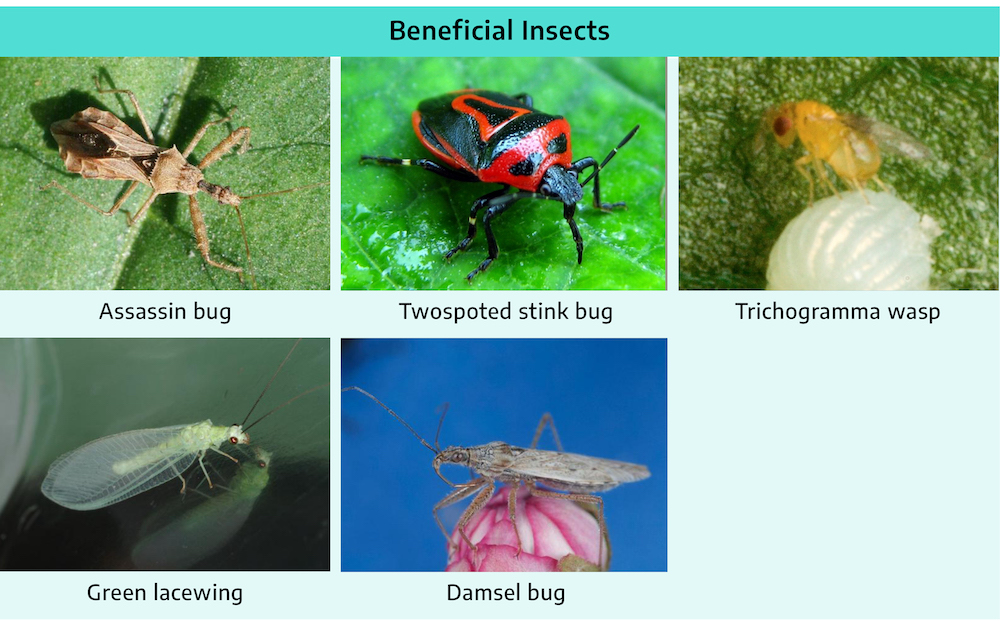
Taxonomy
Taxonomy is the science of classifying life into a hierarchical scheme with categories of varying ranks. Identification of the hundreds of thousands of species of insects would be impossible if they were not organized around a standard classification system that groups organisms according to their shared characteristics. All life on Earth is divided into six kingdoms, the highest level of the classification system: Eubacteria, Archaeabacteria, Protista, Fungi, Animalia, and Plantae. Each kingdom is further divided into smaller phyla. For example, several of the phyla that contain agricultural and horticultural pests in the animal kingdom are:
- Arthropoda (insects, spiders, mites, crayfish, millipedes)
- Nematoda (roundworms, trichina)
- Platyhelminthes (flatworms, flukes, tapeworms)
- Mollusca (snails, slugs, clams)
Phyla are subdivided into classes, which are composed of orders. Orders are composed of families, which contain genera, in which the species are ultimately placed. High school biology students may remember the phrase “Keep Putting Coffee On For Good Students,” or a similar mnemonic device to help remember the whole classification arrangement of kingdom through species.
Phylum Arthropoda and its Classes
Insects belong to the phylum Arthropoda. Arthropods are a very important group of animals, representing more than 80% of all described living animal species. Familiar arthropods include spiders, ticks, crabs, scorpions, shrimp, barnacles, and insects. All arthropods share some common characteristics, such as segmented bodies, paired segmented appendages, bilateral symmetry, and an exoskeleton (an outer “skin” or “shell” that serves as an external skeleton) that is periodically shed as the arthropod grows. Insects belong to the class Insecta.
Orders of the class Insecta
Classes are further divided into orders. Orders in the class Insecta are based on the type of metamorphosis, mouthparts, and wings an insect may have. Insect orders are further broken down into smaller groupings called the family. Each family is a more select group of very closely related insects. Family names end with “-idae.” Aphidae (aphids), Muscidae (house flies), and Acrididae (grasshoppers) are examples of families of insects.
Families are divided into genera, which are finally divided into species. These are the most finite levels of our classification system. The house fly, Musca domestica, serves here as an example of specific classification:
- Phylum: Arthropoda
- Class: Insecta
- Order: Diptera
- Family: Muscidae
- Genus: Musca
- Species: domestica
- Common name: house fly
Musca domestica is the scientific name for the house fly. The scientific name of an organism includes both its genus and species names. The scientific name is always italicized and only the genus name is capitalized. Many insects, but not all, have common names; sometimes a single species will have several common names. For example, Heliothis zea is called the corn earworm when found on corn, but it is a tomato fruitworm when found on tomatoes. Using scientific names eliminates the confusion that can occur when an insect has several common names, or if one common name is used for more than one species. Common names can also refer to large groups of insects, such as families or orders. The entire order Coleoptera is known as the beetles. The term moth refers to thousands of species in the order Lepidoptera.
Note: Invertebrate taxonomy often changes to reflect ongoing research into the relationships among organisms. Species are moved from genus to genus, whole families can be combined with another family, and changes sometimes occur even at the level of orders. One resource that stays up-to-date on the current state of insect taxonomy is the website bugguide.net. This website has a wealth of material on insects, spiders, and related arthropods, including a fantastic gallery of photos.
Table 3-4: Commonly seen orders of the class Insecta
| Order | Common Name | Habitat | Metamorphosis | Mouthparts | Wings |
|---|---|---|---|---|---|
| Zygentoma | Silverfish | Leaf litter and soil; indoors | Gradual | Chewing | None |
| Ephemeroptera | Mayflies | Aquatic or near water | Gradual | Vestigial | 2 pairs |
| Odonata | Dragonflies, damselflies | Aquatic or near water | Gradual | Chewing | 2 pairs |
| Dermaptera | Earwigs | On vegetation; leaf litter | Gradual | Chewing | 2 pairs, sometimes reduced in size or absent |
| Plecoptera | Stoneflies | Aquatic or near water | Gradual | Chewing | 2 pairs, sometimes reduced in size or absent |
| Orthoptera | Grasshoppers, crickets, katydids | On vegetation; leaf litter | Gradual | Chewing | 2 pairs, sometimes reduced in size or absent |
| Phasmida | Walkingsticks | On vegetation | Gradual | Chewing | In the U.S., none or 2 pairs very reduced in size |
| Mantodea | Mantids | On vegetation | Gradual | Chewing | 2 pairs |
| Blattodea | Cockroaches, termites | Leaf litter and woody plant debris; in buildings; subterranean | Gradual | Chewing | 2 pairs on reproductive termites; 2 pairs, sometimes reduced in size, on cockroaches |
| Thysanoptera | Thrips | On vegetation | Intermediate between simple and complex | Rasping-sucking | 2 pairs |
| Hemiptera | True bugs, cicadas, aphids, leafhoppers, scales, and allies | On vegetation; aquatic; in leaf litter | Gradual | Piercing-sucking | 2 pairs, sometimes reduced or absent |
| Psocodea | Booklice, barklice, and parasitic lice | Booklice are found in buildings; barklice on trees; parasitic lice on birds and mammals | Gradual | Chewing; piercing-sucking | 2 pairs, sometimes reduced or absent in booklice and barklice; none in parasitic lice |
| Neuroptera | Dobsonflies, antlions, lacewings, and allies | Aquatic or near water; on vegetation; in soil and leaf litter | Complete | Chewing | 2 pairs |
| Coleoptera | Beetles | Everywhere | Complete | Chewing | 2 pairs, sometimes reduced in size or absent |
| Hymenoptera | Ants, bees, wasps, sawflies | Everywhere | Complete | Chewing-lapping | 2 pairs, sometimes reduced in size or absent |
| Lepidoptera | Butterflies, moths | On vegetation or plant materials | Complete | Chewing siphoning | 2 pairs, sometimes absent |
| Siphonaptera | Fleas | In association with birds and mammal hosts | Complete | Piercing-sucking | None |
| Diptera | Flies | Everywhere | Complete | Piercing-sucking, sponging | 1 pair |
Summary
The class Insecta is larger than all of the other classes in the Animal kingdom combined. Insect species vary greatly in size, color, shape, life history, and favored habitat. Most insects are harmless or even beneficial, but the few that cause damage have tremendous impact on the world. Insects can usually be recognized with practice and some knowledge of their host, habitat, and life cycle. Feeding damage by pest insects varies according to the type of mouthparts possessed by the insect.
Additional Resources
- Resources for Entomology section on the VCE publications website
- A Field Guide to Insects North of Mexico, by Donald J. Borrer and Richard E. White
- Garden insects of North America: The Ultimate Guide, by Whitney Cranshaw
- Bugs Rule!, An Introduction to the World of Insects by Whitney Cranshaw
- Bugguide.net
Attributions
- Elizabeth Brown, Bedford Extension Master Gardener (2021 reviser)
- Jim Revell, Bedford Extension Master Gardener (2021 reviser)
- Theresa Dellinger, Collections Manager, Virginia Tech Insect Collection, Department of Entomology (2021 image advice and revisions)
- Theresa Dellinger, Collections Manager, Virginia Tech Insect Collection, Department of Entomology (2015 reviser)
- Eric Day, Manager, Insect Identification Lab, Department of Entomology (2015 reviser)
- Additional Contributions by Dan Nortman, Extension Agent, Agriculture and Natural Resources (2015), Peter Warren, Extension Agent, Agriculture and Natural Resources (2009)
Image Attributions
- Figure 3-1: Insect body parts. Johnson, Devon. 2022. CC BY-NC-SA 4.0. Adapted from Master Gardener Training Handbook, Virginia Cooperative Extension, 2018.
- Figure 3-2: Mouthparts. Johnson, Devon. 2022. CC BY-NC-SA 4.0. Adapted from Master Gardener Training Handbook, Virginia Cooperative Extension, 2018.
- Figure 3-3: Leg adaptations. Johnson, Devon. 2022. CC BY-NC-SA 4.0. Includes image “Male front leg from underside” by Siga from Wikipedia, public domain, image 5190034 by Natasha Wright, Braman Termite & Pest Elimination, Bugwood.org (CC BY-NC 3.0 US), image 5524210 by Keren Levy, Bugwood.org (CC BY-NC 3.0 US), image 5552100 by Seastone, L. and B. Parks, Museum Collections: Orthoptera, USDA APHIS PPQ, Bugwood.org (CC BY-NC 3.0 US), and image 5465396 by Pest and Diseases Image Library, Bugwood.org (CC BY-NC 3.0 US).
- Figure 3-4: Types of wings. Johnson, Devon. 2022. CC BY-NC-SA 4.0. Includes image 5296002 by Forest and Kim Starr, Starr Environmental, Bugwood.org (CC BY-NC 3.0 US), image 5582501 by Steven Katovich, Bugwood.org (CC BY-NC 3.0 US), image 5376044 by David Cappaert, Bugwood.org (CC BY-NC 3.0 US), image 1236053 by Clemson University – USDA Cooperative Extension Slide Series , Bugwood.org (CC BY-NC 3.0 US), and image 5530014 by David Stephens, Bugwood.org (CC BY-NC 3.0 US).
- Figure 3-5: Without metamorphosis. Johnson, Devon. 2022. CC BY-NC-SA 4.0. Adapted from Master Gardener Training Handbook, Virginia Cooperative Extension, 2018.
- Figure 3-6: Gradual metamorphosis. Johnson, Devon. 2022. CC BY-NC-SA 4.0. Adapted from Master Gardener Training Handbook, Virginia Cooperative Extension, 2018.
- Figure 3-7: Incomplete metamorphosis. Johnson, Devon. 2022. CC BY-NC-SA 4.0. Adapted from Master Gardener Training Handbook, Virginia Cooperative Extension, 2018.
- Figure 3-8: Complete metamorphosis. Johnson, Devon. 2022. CC BY-NC-SA 4.0. Adapted from Master Gardener Training Handbook, Virginia Cooperative Extension, 2018.
- Figure 3-9: Chewing damage. Johnson, Devon. 2022. CC BY-NC-SA 4.0. Includes image 5443232 by Whitney Cranshaw from Bugwood.org (CC BY 3.0 US).
- Figure 3-10: Piercing-sucking damage. Johnson, Devon. 2022. CC BY-NC-SA 4.0. Includes image 1150004 by Andrew J. Boone from Bugwood.org (CC BY-NC 3.0 US).
- Figure 3-11: Internal feeder damage. Johnson, Devon. 2022. CC BY-NC-SA 4.0. Includes image 5378685 by Milan Zubrik from Bugwood.org (CC BY-NC 3.0 US), image 1263040 by National Plant Protection Organization, the Netherlands from Bugwood.org (CC BY-NC 3.0 US), and image 5443216 by Whitney Cranshaw from Bugwood.org (CC BY 3.0 US).
- Figure 3-12: Subterranean damage. Johnson, Devon. 2022. CC BY-NC-SA 4.0. Includes image 0284074 by James Solomon from Bugwood.org (CC BY 3.0 US).
- Figure 3-13: Egg laying damage. Johnson, Devon. 2022. CC BY-NC-SA 4.0. Includes image 1669003 by Bruce W. Kauffman from Bugwood.org (CC BY-NC 3.0 US) and image 1398081 by Steven Katovich from Bugwood.org CC BY 3.0 US).
- Figure 3-14: Orthoptera includes grasshoppers, crickets, and katydids. Johnson, Devon. 2022. CC BY-NC-SA 4.0. Includes image 5602869 by Gerald Holmes from Bugwood.org (CC BY-NC 3.0 US), image 5573940 by Joseph Berger from Bugwood.org (CC BY 3.0 US), and image 2158015 by David Cappaert from Bugwood.org (CC BY-NC 3.0 US).
- Figure 3-15: Blattodea includes cockroaches and termites. Johnson, Devon. 2022. CC BY-NC-SA 4.0. Includes image 5581708 by Whitney Cranshaw from Bugwood.org (CC BY 3.0 US) and image 1324033 by USDA ARS Photo Unit from Bugwood.org (CC BY 3.0 US).
- Figure 3-16: Mantodea includes mantids, pictured Chinese mantis (Tenodera sinensis sinensis). Johnson, Devon. 2022. CC BY-NC-SA 4.0. Includes image 5604040 by Gerald Holmes from Bugwood.org (CC BY-NC 3.0 US).
- Figure 3-17: Phasmida includes walkingsticks, pictured walkingstick (Diapheromera femorata). Johnson, Devon. 2022. CC BY-NC-SA 4.0. Includes image 5490116 by David Cappaert from Bugwood.org (CC BY-NC 3.0 US).
- Figure 3-18: Dermaptera includes earwigs, pictured European earwig (Forficula auricularia). Johnson, Devon. 2022. CC BY-NC-SA 4.0. Includes image 5443277 by Whitney Cranshaw from Bugwood.org (CC BY 3.0 US).
- Figure 3-19: Hemiptera includes aphids, cicada, euonymus scale, wax scale, mealybug, whitefly, stink bug, wheel bug, milkweed bug. Johnson, Devon. 2022. CC BY-NC-SA 4.0. Includes image 5445767 by Dani Barchana from Bugwood.org (CC BY-NC 3.0 US), image 5565787 by Paul Langlois from Bugwood.org (CC BY-NC 3.0 US), image 5560871 by Chris Evans from Bugwood.org (CC BY-NC 3.0 US), image 1626029 by John A. Weidhass from Bugwood.org (CC BY 3.0 US), image 5599978 by Matthew Borden from Bugwood.org (CC BY 3.0 US), image 5581522 by Henry Juarez from Bugwood.org (CC BY-NC 3.0 US), image 5612242 by Rebekah D. Wallace from Bugwood.org (CC BY-NC 3.0 US), image 9009079 by Herbert A. ‘Joe’ Pase III from Bugwood.org (CC BY-NC 3.0 US), and image 5347031 by William M. Ciesla from Bugwood.org (CC BY-NC 3.0 US).
- Figure 3-20: Thysanoptera includes thrips, pictured tobacco thrips (Frankliniella fusca). Johnson, Devon. 2022. CC BY-NC-SA 4.0. Includes image 1389005 by David Jones from Bugwood.org (CC BY 3.0 US).
- Figure 3-21: Coloptera includes ground beetle (pictured Harpalus distinguendus), bark beetles (pictured subfamily Scolytinae), blister beetle (pictured Linsleya californica), flour beetle (pictured small-eyed flour beetle Palorus ratzeburgi), leaf beetle (Isotes mexicana), longhorned beetles (pictured flat-faced longhorned beetle Neohebestola humeralis), weevils (pictured marsh weevil Onychylis meridionalis), and woodboring beetles (pictured cottonwood borer Plectrodera scalator). Johnson, Devon. 2022. CC BY-NC-SA 4.0. Includes image 5581934 by Mary C Legg from Bugwood.org (CC BY-NC 3.0 US), image 5598826 by Mohammed El Damir from Bugwood.org (CC BY 3.0 US), image 5594932 by Hanna Royals from Bugwood.org (CC BY-NC 3.0 US), image 5550056 by Hanna Royals from Bugwood.org (CC BY-NC 3.0 US), image 5598022 by Ryan Armbrust from Bugwood.org (CC BY-NC 3.0 US), image 5607975 by Paul Langlois from Bugwood.org (CC BY-NC 3.0 US), image 5599996 by Paul Langlois from Bugwood.org (CC BY-NC 3.0 US), image 5607890 by Paul Langlois from Bugwood.org (CC BY-NC 3.0 US), and image 5511473 by Robert J. Bauernfeind from Bugwood.org (CC BY-NC 3.0 US).
- Figure 3-22: Diptera includes crane flies (pictured Tipula sp.), flower fly (pictured Helophilus sp.), midges (pictured aphid predatory midge Aphidoletes aphidimyza), syrphid flies (pictured Syrphus sp.), tachina flies (pictured spiny tachina fly Paradejeania rutilioides), vinegar fly (pictured Scaptomyza sp.). Johnson, Devon. 2022. CC BY-NC-SA 4.0. Includes image 5424150 by David Cappaert from Bugwood.org (CC BY-NC 3.0 US), image 5443509 by Jon Yuschock from Bugwood.org (CC BY-NC 3.0 US), image 5598726 by Ward Strong from Bugwood.org (CC BY-NC 3.0 US), image 5595559 by Ansel Oommen from Bugwood.org (CC BY-NC 3.0 US), image 5382157 by Whitney Cranshaw from Bugwood.org (CC BY 3.0 US), and image 5402545 by Joseph Berger from Bugwood.org (CC BY 3.0 US).
- Figure 3-23: Hymenoptera includes bees (pictured honey bee Apis mellifera), Braconid wasp (Wroughtonia occidentalis), Chalcid wasp (Torymus druparum), Ichneumonid parasitoid wasps (Enicospilus sp.), horntail wasps (pictured blue horntail woodwasp Sirex cyaneus), sawflies (pictured redheaded pine sawfly Neodiprion lecontei) , mud daubers (pictured black and yellow mud dauber Sceliphron caementarium), and ants (pictured Formica sp.). Johnson, Devon. 2022. CC BY-NC-SA 4.0. Includes image 5598195 by Hanna Royals from Bugwood.org (CC BY-NC 3.0 US), image 5583935 by Paul Langlois from Bugwood.org (CC BY-NC 3.0 US), image 5583921 by Paul Langlois from Bugwood.org (CC BY-NC 3.0 US), image 5611811 by Rebekah D. Wallace from Bugwood.org (CC BY-NC 3.0 US), image 5458756 by Pest and Diseases Image Library from Bugwood.org (CC BY-NC 3.0 US), image 9009072 by Herbert A. ‘Joe’ Pase III from Bugwood.org (CC BY-NC 3.0 US), image 5482934 by USDA Forest Service – Southern Research Station from Bugwood.org (CC BY-NC 3.0 US), and image 5598442 by Ward Strong from Bugwood.org (CC BY-NC 3.0 US).
- Figure 3-24: Lepidoptera adults includes: cabbage white or imported cabbage worm (Pieris rapae), Nickerl’s fritillary (Melitaea aurelia), imperial moth (Eacles imperialis), luna moth (Actias luna), polyphemus moth (Antheraea polyphemus), and codling moth (Cydia pomonella). Johnson, Devon. 2022. CC BY-NC-SA 4.0. Includes image 5559869 by Hanna Royals from Bugwood.org (CC BY-NC 3.0 US), image 5582245 by Mary C Legg from Bugwood.org (CC BY-NC 3.0 US), image 2089014 by Lacy L. Hyche from Bugwood.org (CC BY 3.0 US), image 5424219 by David Cappaert from Bugwood.org (CC BY-NC 3.0 US), image 5585710 by Sturgis McKeever from Bugwood.org (CC BY 3.0 US), and image 5578713 by Mourad Louadfel from Bugwood.org (CC BY-NC 3.0 US).
- Figure 3-25: Lepidoptera larvae includes: azalea caterpillar (Datana major), evergreen bagworm (Thyridopteryx ephemeraeformis), hickory horned devil (Citheronia regalis), linden looper (Erannis tiliaria), yellownecked caterpillar (Datana ministra), and corn earworm or tomato fruitworm (Helicoverpa zea). Johnson, Devon. 2022. CC BY-NC-SA 4.0. Includes image 2118035 by Chris Evans from Bugwood.org (CC BY-NC 3.0 US), image 5603961 by Gerald Holmes from Bugwood.org (CC BY-NC 3.0 US), image 5482801 by Johnny N. Dell from Bugwood.org (CC BY-NC 3.0 US), image 5493120 by William M. Ciesla from Bugwood.org (CC BY-NC 3.0 US), image 0014042 by Gerald J. Lenhard from Bugwood.org (CC BY 3.0 US), and image 5596837 by Whitney Cranshaw from Bugwood.org (CC BY 3.0 US).
- Figure 3-26: Neuroptera includes giant antlion (Palpares sp.), dobsonfly (Corydalus cornutus), dusty-wings, lacewings (family Chrysopidae), and snakeflies. Johnson, Devon. 2022. CC BY-NC-SA 4.0. Includes image 5577750 by Whitney Cranshaw from Bugwood.org (CC BY 3.0 US), image 5379934 by Jessica Louque from Bugwood.org (CC BY 3.0 US), image 5596739 by Whitney Cranshaw from Bugwood.org (CC BY 3.0 US), image 5564611 by Johnny N. Dell from Bugwood.org (CC BY-NC 3.0 US), and image 5207007 by David Leatherman from Bugwood.org (CC BY-NC 3.0 US).
- Figure 3-27: Arachnida includes: black widow spider (Latrodectus mactans), wolf spiders (family Lycosidae), mites (pictured twospotted spider mite Tetranychus urticae), American dog tick (Dermacentor variabilis), lone star tick (Amblyomma americanum) and daddy longlegs or harvestmen (Leiobunum sp.). Johnson, Devon. 2022. CC BY-NC-SA 4.0. Includes image 5361242 by Frank Peairs from Bugwood.org (CC BY 3.0 US), image 1528004 by Sturgis McKeever from Bugwood.org (CC BY-NC 3.0 US), image 5387671 by Joseph Berger from Bugwood.org (CC BY 3.0 US), image 5532835 by Mohammed El Damir from Bugwood.org (CC BY 3.0 US), image 0001049 by Centers for Disease Control and Prevention from Bugwood.org (CC BY 3.0 US), and image 1225122 by Edward L. Manigault from Bugwood.org (CC BY 3.0 US).
- Figure 3-28: Ticks that commonly bite humans. Centers for Disease Control and Prevention. (retrieved 2022). Public Domain.
- Figure 3-29: Beneficial insects: Assassin bug (pictured spined assassin bug Sinea diadema), Predaceous stink bugs (pictured twospotted stink bug, Perillus bioculatus (F.), Trichogramma wasps (pictured Trichogramma ostriniae); Green lacewing (pictured Chrysoperla rufilabris), Damsel bug (pictured common damsel bug Nabis americoferus). Johnson, Devon. 2022. CC BY-NC-SA 4.0. Includes image 5367980 by Russ Ottens from Bugwood.org (CC BY 3.0 US), image 5175038 by Kevin D. Arvin from Bugwood.org (CC BY 3.0 US), image 5526014 by Peggy Greb from Bugwood.org (CC BY-NC 3.0 US), image 1386016 by Joseph Berger from Bugwood.org (CC BY 3.0 US), and image 5435576 by Joseph Berger from Bugwood.org (CC BY 3.0 US).
The outer covering of the insect, includes most of the material of the exoskeleton
The primary component of the exoskeletons of arthropods such as crustaceans and insects
Hardened plates joined together forming the hard surface of insects
Typically paired appendages on the abdomen of many species of insect, typically with sensory function
An insect that undergoes slight or no metamorphosis
An insect that undergoes complete metamorphosis with four distinct stages of development
deformity in a woody plant where a mass of shoots grows from a single point

